Kristine Hughes's Blog, page 100
November 22, 2013
A Miniature Treat at Windsor Castle
Most everything at Windsor Castle is GREAT. I hope you will share all these great things with Kristine and me (Victoria) next September, 2014, on the Wellington Tour. For more info on the tour, click here.
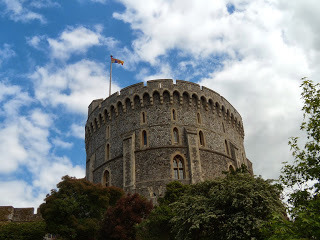
There is one small thing -- or lots of small things -- that add up to an attraction as great as all of Windsor's other sights. Queen Mary's Dollhouse is truly amazing. It is one of those things in England I can't get enough of. Though I've visited many times, I am always eager to see it again.
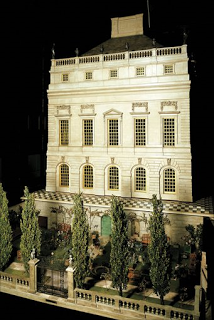
Queen Mary's Dollhouse was an inspiration of Princess Marie Louise (1872-1956), a granddaughter of Queen Victoria, who was a friend of renowned architect Sir Edwin Lutyens (1869-1944). She envisioned the dollhouse as a showcase for English craftsmen. Lutyens designed the Edwardian-style London House after 1920 and it was completed in 1924, furnished with exquisite miniatures at a scale of one-to-twelve. To visit the website, click here.
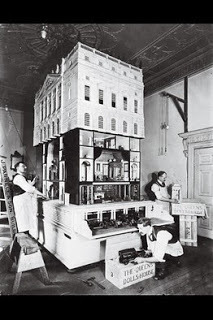 Unpacking the contents Once completed, the Dollhouse was displayed for several years to the public in various venues with funds raised from admissions used for charitable purposes. Eventually, it was installed permanently at the Castle; currently, part of the fee from admission is still given to charity.
Unpacking the contents Once completed, the Dollhouse was displayed for several years to the public in various venues with funds raised from admissions used for charitable purposes. Eventually, it was installed permanently at the Castle; currently, part of the fee from admission is still given to charity.
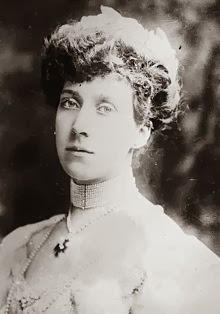 Princess Marie Louise, c. 1910 Princess Marie Louise was a patroness of the arts, devoted to supporting British artists and craftsmen in the difficult days following WWI. With her assistance and that of Lutyens, hundreds of prominent Britons participated in building and furnishing the project. For example, the garden (located in a drawer below the house and seen in the views above) was designed by famed landscaper Gertrude Jekyll (1843-1932);
Princess Marie Louise, c. 1910 Princess Marie Louise was a patroness of the arts, devoted to supporting British artists and craftsmen in the difficult days following WWI. With her assistance and that of Lutyens, hundreds of prominent Britons participated in building and furnishing the project. For example, the garden (located in a drawer below the house and seen in the views above) was designed by famed landscaper Gertrude Jekyll (1843-1932);
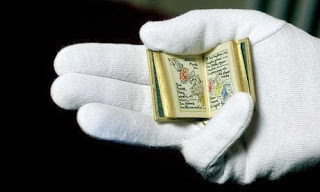 A fairy tale in miniature The book above was hand written by Cyril Kenneth Bird, aka Fougasse, for the library. It measures 1/6 x 1.4 inches.
A fairy tale in miniature The book above was hand written by Cyril Kenneth Bird, aka Fougasse, for the library. It measures 1/6 x 1.4 inches. 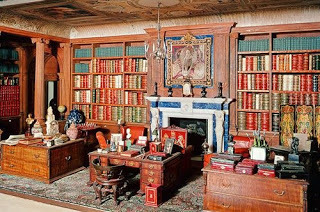 The Library Among the 200-plus volumes in the library are works by authors Thomas Hardy, Rudyard Kipling, Sir Arthur Conan Doyle, and Edith Wharton.
The Library Among the 200-plus volumes in the library are works by authors Thomas Hardy, Rudyard Kipling, Sir Arthur Conan Doyle, and Edith Wharton.
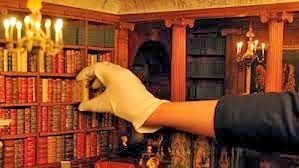
On the center floor in the picture below, the saloon is shown, with portraits of King George V and Queen Mary. Below is the dining room.
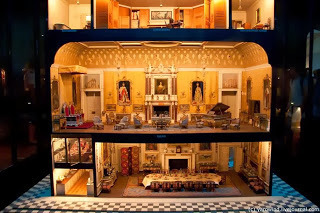
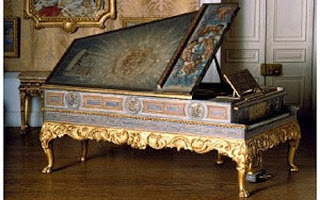 Grand Piano in the Saloon
Grand Piano in the Saloon
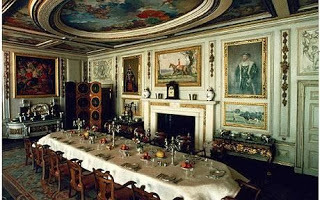 The Dining Room The Dollhouse is served with running water, a flushing loo, electric lights, and a working lift.
The Dining Room The Dollhouse is served with running water, a flushing loo, electric lights, and a working lift.
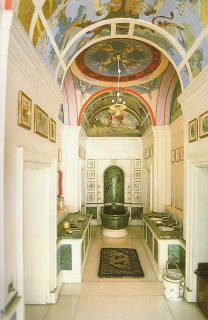 The Elegant Bathroom
The Elegant Bathroom
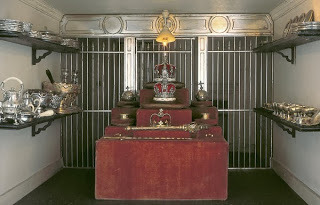 The Crown Jewels are well protected
The Crown Jewels are well protected
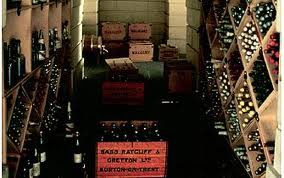 Actual wine fills the bottles in the Wine Cellar.from Berry Bros., St. James Street
Actual wine fills the bottles in the Wine Cellar.from Berry Bros., St. James Street
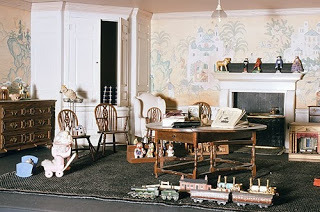 In the manner of the Edwardian era, the Nursery is on the top floor
In the manner of the Edwardian era, the Nursery is on the top floor
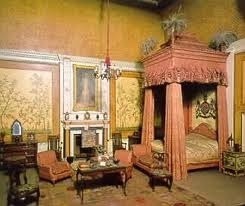 The King's Bed Chamber This is just a small selection of what you will see at Queen Mary's Doll House when you join Kristine and me at Windsor Castle, as part of The Wellington Tour in September, 2014. For Details: http://wellingtontour.blogspot.com
The King's Bed Chamber This is just a small selection of what you will see at Queen Mary's Doll House when you join Kristine and me at Windsor Castle, as part of The Wellington Tour in September, 2014. For Details: http://wellingtontour.blogspot.com

There is one small thing -- or lots of small things -- that add up to an attraction as great as all of Windsor's other sights. Queen Mary's Dollhouse is truly amazing. It is one of those things in England I can't get enough of. Though I've visited many times, I am always eager to see it again.

Queen Mary's Dollhouse was an inspiration of Princess Marie Louise (1872-1956), a granddaughter of Queen Victoria, who was a friend of renowned architect Sir Edwin Lutyens (1869-1944). She envisioned the dollhouse as a showcase for English craftsmen. Lutyens designed the Edwardian-style London House after 1920 and it was completed in 1924, furnished with exquisite miniatures at a scale of one-to-twelve. To visit the website, click here.
 Unpacking the contents Once completed, the Dollhouse was displayed for several years to the public in various venues with funds raised from admissions used for charitable purposes. Eventually, it was installed permanently at the Castle; currently, part of the fee from admission is still given to charity.
Unpacking the contents Once completed, the Dollhouse was displayed for several years to the public in various venues with funds raised from admissions used for charitable purposes. Eventually, it was installed permanently at the Castle; currently, part of the fee from admission is still given to charity.
 Princess Marie Louise, c. 1910 Princess Marie Louise was a patroness of the arts, devoted to supporting British artists and craftsmen in the difficult days following WWI. With her assistance and that of Lutyens, hundreds of prominent Britons participated in building and furnishing the project. For example, the garden (located in a drawer below the house and seen in the views above) was designed by famed landscaper Gertrude Jekyll (1843-1932);
Princess Marie Louise, c. 1910 Princess Marie Louise was a patroness of the arts, devoted to supporting British artists and craftsmen in the difficult days following WWI. With her assistance and that of Lutyens, hundreds of prominent Britons participated in building and furnishing the project. For example, the garden (located in a drawer below the house and seen in the views above) was designed by famed landscaper Gertrude Jekyll (1843-1932);
 A fairy tale in miniature The book above was hand written by Cyril Kenneth Bird, aka Fougasse, for the library. It measures 1/6 x 1.4 inches.
A fairy tale in miniature The book above was hand written by Cyril Kenneth Bird, aka Fougasse, for the library. It measures 1/6 x 1.4 inches.  The Library Among the 200-plus volumes in the library are works by authors Thomas Hardy, Rudyard Kipling, Sir Arthur Conan Doyle, and Edith Wharton.
The Library Among the 200-plus volumes in the library are works by authors Thomas Hardy, Rudyard Kipling, Sir Arthur Conan Doyle, and Edith Wharton.

On the center floor in the picture below, the saloon is shown, with portraits of King George V and Queen Mary. Below is the dining room.

 Grand Piano in the Saloon
Grand Piano in the Saloon
 The Dining Room The Dollhouse is served with running water, a flushing loo, electric lights, and a working lift.
The Dining Room The Dollhouse is served with running water, a flushing loo, electric lights, and a working lift.  The Elegant Bathroom
The Elegant Bathroom  The Crown Jewels are well protected
The Crown Jewels are well protected Actual wine fills the bottles in the Wine Cellar.from Berry Bros., St. James Street
Actual wine fills the bottles in the Wine Cellar.from Berry Bros., St. James Street In the manner of the Edwardian era, the Nursery is on the top floor
In the manner of the Edwardian era, the Nursery is on the top floor
 The King's Bed Chamber This is just a small selection of what you will see at Queen Mary's Doll House when you join Kristine and me at Windsor Castle, as part of The Wellington Tour in September, 2014. For Details: http://wellingtontour.blogspot.com
The King's Bed Chamber This is just a small selection of what you will see at Queen Mary's Doll House when you join Kristine and me at Windsor Castle, as part of The Wellington Tour in September, 2014. For Details: http://wellingtontour.blogspot.com
Published on November 22, 2013 00:30
November 20, 2013
Video Wednesday
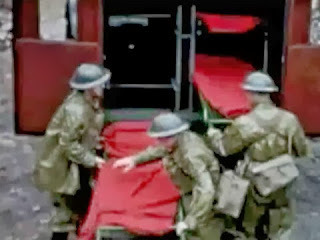
Colour footage of London during the Blitz shot by Alfred Coucher, wartime mayor and chief air raid warden of Marylebone, west London. The film comes to light 70 years after having been stored in his attic. Watch the six minute video covering it's discovery, listen to historians discuss the impact of the Blitz on London and learn about the Blitz Project and the on-going digitalization of the online archives.
Published on November 20, 2013 00:00
November 18, 2013
London Wrap Up
Here I am, sadly coming to the end of the extended account of my Summer, 2013, visit to England. But I am thinking ahead to our Wellington Tour in September, 2014, when Kristine and I hope many of our readers will join us, beginning in London on September 4.
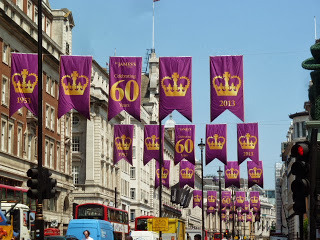
Last July, Britain was commemorating the Diamond Jubilee of HM Elizabeth, and the main thoroughfares were decked in purple and gold flags. The country was also eagerly anticipating the birth of a royal heir, which occurred shortly after we returned to the US.
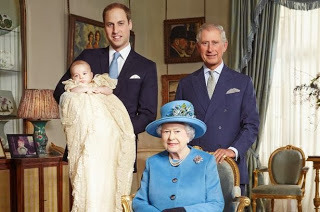 The Day of the Christening October 23, 2013Prince George of Cambridge, his father, grandfather and great-grandmother, The Queen For the past few weeks, I've been chronicling my trip with Ed, who suffered from a very sore foot and had considerable pain. Nothing can be fun when your feet are sore! But he was brave -- and determined, so he limped onward through Cambridge, touring the stately estates of Houghton and Holkham Halls, and tramping around London, from Horse Guards and St. James and Mayfair, to the St. Pancras-King's Cross neighborhood, and finally to the Wellington Arch and Apsley House.
The Day of the Christening October 23, 2013Prince George of Cambridge, his father, grandfather and great-grandmother, The Queen For the past few weeks, I've been chronicling my trip with Ed, who suffered from a very sore foot and had considerable pain. Nothing can be fun when your feet are sore! But he was brave -- and determined, so he limped onward through Cambridge, touring the stately estates of Houghton and Holkham Halls, and tramping around London, from Horse Guards and St. James and Mayfair, to the St. Pancras-King's Cross neighborhood, and finally to the Wellington Arch and Apsley House.
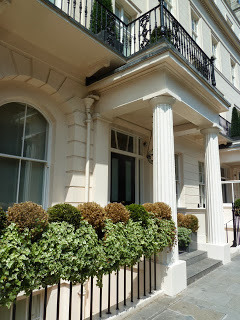 Handsome town houses along Grosvenor Crescent After leaving Apsley House, we tried to calculate the most direct route to our restaurant, but in the curves and corners of the adjacent streets, it was no easy task to keep Ed on his feet as little as possible. The scenery was excellent, however, fine townhouses, many converted to commercial use or serving as embassies.
Handsome town houses along Grosvenor Crescent After leaving Apsley House, we tried to calculate the most direct route to our restaurant, but in the curves and corners of the adjacent streets, it was no easy task to keep Ed on his feet as little as possible. The scenery was excellent, however, fine townhouses, many converted to commercial use or serving as embassies.
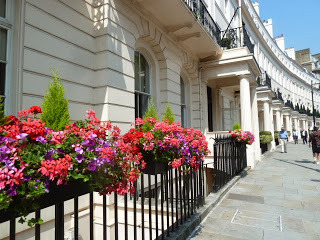 More of the same
More of the same
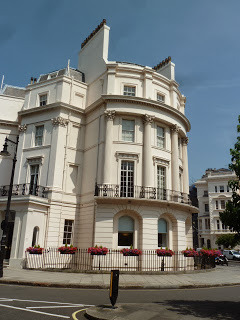 On our walk to The Grenadier
On our walk to The Grenadier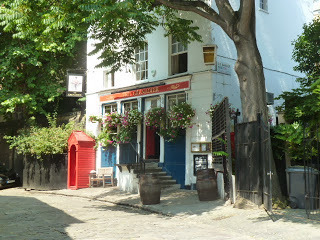 The Grenadier, a delightful pub, beloved of Wellington's troops The modest little building has a long and celebrated history, including stories of the 1st Duke of Wellington and his troops, various ghosts, even up to the locals who were only momentarily disturbed by the limping tourists. The food is right up to date, however, and delicious.
The Grenadier, a delightful pub, beloved of Wellington's troops The modest little building has a long and celebrated history, including stories of the 1st Duke of Wellington and his troops, various ghosts, even up to the locals who were only momentarily disturbed by the limping tourists. The food is right up to date, however, and delicious. 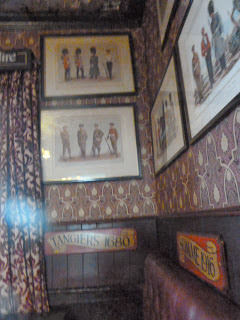 Inside the Grenadier Kristine and I hope to welcome you to dinner at the Grenadier, included in The Wellington Tour. We'll be here on Saturday, September 6, 2014, so make plans to join us in London and touring a bit of southern England. For details: http://wellingtontour.blogspot.com/
Inside the Grenadier Kristine and I hope to welcome you to dinner at the Grenadier, included in The Wellington Tour. We'll be here on Saturday, September 6, 2014, so make plans to join us in London and touring a bit of southern England. For details: http://wellingtontour.blogspot.com/
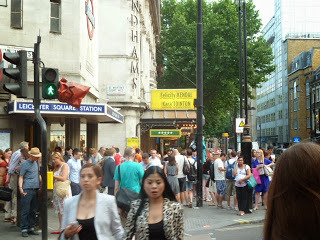 Charing Cross Road, London, July 17, 2013 Since it wouldn't be a trip to London without an evening of theatre, I sent Ed back to the hotel for a nap and went to find tickets for a play he'd enjoy that evening, preferably a comedy. Whether it was just good luck or London Karma, I got off the tube at Leicester Square station, and right next door was Wyndham's Theatre where a play I had on my list was selling tickets in the lobby. Eureka!
Charing Cross Road, London, July 17, 2013 Since it wouldn't be a trip to London without an evening of theatre, I sent Ed back to the hotel for a nap and went to find tickets for a play he'd enjoy that evening, preferably a comedy. Whether it was just good luck or London Karma, I got off the tube at Leicester Square station, and right next door was Wyndham's Theatre where a play I had on my list was selling tickets in the lobby. Eureka!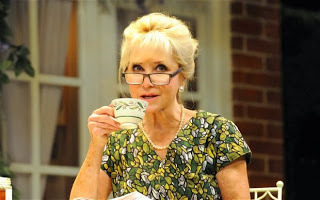 Felicity Kendal as Sheila in Relatively Speaking Relatively Speaking by Alan Ayckbourn was first produced in 1965, but the revival held up perfectly as a funny but dark play about ironic misunderstandings and outright lies. Felicity Kendal has had a long career in television and movies, as well as the stage; I think I remember her most as Rosemary in Rosemary and Thyme, a British mystery series that has played on my local PBS station. She was perfect in her role in this play, as were the other actors. We left laughing, but what character besides Sheila was a person we'd like to know? Ayckbourn, author of about 77 plays, definitely has the last laugh.
Felicity Kendal as Sheila in Relatively Speaking Relatively Speaking by Alan Ayckbourn was first produced in 1965, but the revival held up perfectly as a funny but dark play about ironic misunderstandings and outright lies. Felicity Kendal has had a long career in television and movies, as well as the stage; I think I remember her most as Rosemary in Rosemary and Thyme, a British mystery series that has played on my local PBS station. She was perfect in her role in this play, as were the other actors. We left laughing, but what character besides Sheila was a person we'd like to know? Ayckbourn, author of about 77 plays, definitely has the last laugh.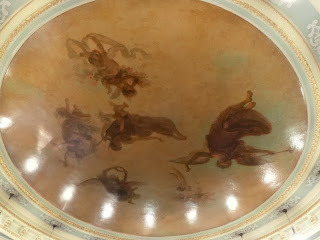 A snap of the ceiling before they announced "No Cameras."
A snap of the ceiling before they announced "No Cameras."The play was a perfect ending to a wonderful trip, for all that was left was repacking and the Heathrow Express before winging homeward. Now, several months have passed, and Ed's foot has healed up nicely. And I have been planning, planning, planning for that September tour, perhaps with YOU.
Published on November 18, 2013 00:30
wrapping up london
Here I am, sadly coming to the end of the extended account of my Summer, 2013, visit to England. But I am thinking ahead to our Wellington Tour in September, 2014, when Kristine and I hope many of our readers will join us, beginning in London on September 4.

Last July, Britain was commemorating the Diamond Jubilee of HM Elizabeth, and the main thoroughfares were decked in purple and gold flags. The country was also eagerly anticipating the birth of a royal heir, which occurred shortly after we returned to the US.
 The Day of the Christening October 23, 2013Prince George of Cambridge, his father, grandfather and great-grandmother, The Queen For the past few weeks, I've been chronicling my trip with Ed, who suffered from a very sore foot and had considerable pain. Nothing can be fun when your feet are sore! But he was brave -- and determined, so he limped onward through Cambridge, touring the stately estates of Houghton and Holkham Halls, and tramping around London, from Horse Guards and St. James and Mayfair, to the St. Pancras-King's Cross neighborhood, and finally to the Wellington Arch and Apsley House.
The Day of the Christening October 23, 2013Prince George of Cambridge, his father, grandfather and great-grandmother, The Queen For the past few weeks, I've been chronicling my trip with Ed, who suffered from a very sore foot and had considerable pain. Nothing can be fun when your feet are sore! But he was brave -- and determined, so he limped onward through Cambridge, touring the stately estates of Houghton and Holkham Halls, and tramping around London, from Horse Guards and St. James and Mayfair, to the St. Pancras-King's Cross neighborhood, and finally to the Wellington Arch and Apsley House.
 Handsome town houses along Grosvenor Crescent After leaving Apsley House, we tried to calculate the most direct route to our restaurant, but in the curves and corners of the adjacent streets, it was no easy task to keep Ed on his feet as little as possible. The scenery was excellent, however, fine townhouses, many converted to commercial use or serving as embassies.
Handsome town houses along Grosvenor Crescent After leaving Apsley House, we tried to calculate the most direct route to our restaurant, but in the curves and corners of the adjacent streets, it was no easy task to keep Ed on his feet as little as possible. The scenery was excellent, however, fine townhouses, many converted to commercial use or serving as embassies.
 More of the same
More of the same
 On our walk to The Grenadier
On our walk to The Grenadier The Grenadier, a delightful pub, beloved of Wellington's troops The modest little building has a long and celebrated history, including stories of the 1st Duke of Wellington and his troops, various ghosts, even up to the locals who were only momentarily disturbed by the limping tourists. The food is right up to date, however, and delicious.
The Grenadier, a delightful pub, beloved of Wellington's troops The modest little building has a long and celebrated history, including stories of the 1st Duke of Wellington and his troops, various ghosts, even up to the locals who were only momentarily disturbed by the limping tourists. The food is right up to date, however, and delicious.  Inside the Grenadier Kristine and I hope to welcome you to dinner at the Grenadier, included in The Wellington Tour. We'll be here on Saturday, September 6, 2014, so make plans to join us in London and touring a bit of southern England. For details: http://wellingtontour.blogspot.com/
Inside the Grenadier Kristine and I hope to welcome you to dinner at the Grenadier, included in The Wellington Tour. We'll be here on Saturday, September 6, 2014, so make plans to join us in London and touring a bit of southern England. For details: http://wellingtontour.blogspot.com/
 Charing Cross Road, London, July 17, 2013 Since it wouldn't be a trip to London without an evening of theatre, I sent Ed back to the hotel for a nap and went to find tickets for a play he'd enjoy that evening, preferably a comedy. Whether it was just good luck or London Karma, I got off the tube at Leicester Square station, and right next door was Wyndham's Theatre where a play I had on my list was selling tickets in the lobby. Eureka!
Charing Cross Road, London, July 17, 2013 Since it wouldn't be a trip to London without an evening of theatre, I sent Ed back to the hotel for a nap and went to find tickets for a play he'd enjoy that evening, preferably a comedy. Whether it was just good luck or London Karma, I got off the tube at Leicester Square station, and right next door was Wyndham's Theatre where a play I had on my list was selling tickets in the lobby. Eureka! Felicity Kendal as Sheila in Relatively Speaking Relatively Speaking by Alan Ayckbourn was first produced in 1965, but the revival held up perfectly as a funny but dark play about ironic misunderstandings and outright lies. Felicity Kendal has had a long career in television and movies, as well as the stage; I think I remember her most as Rosemary in Rosemary and Thyme, a British mystery series that has played on my local PBS station. She was perfect in her role in this play, as were the other actors. We left laughing, but what character besides Sheila was a person we'd like to know? Ayckbourn, author of about 77 plays, definitely has the last laugh.
Felicity Kendal as Sheila in Relatively Speaking Relatively Speaking by Alan Ayckbourn was first produced in 1965, but the revival held up perfectly as a funny but dark play about ironic misunderstandings and outright lies. Felicity Kendal has had a long career in television and movies, as well as the stage; I think I remember her most as Rosemary in Rosemary and Thyme, a British mystery series that has played on my local PBS station. She was perfect in her role in this play, as were the other actors. We left laughing, but what character besides Sheila was a person we'd like to know? Ayckbourn, author of about 77 plays, definitely has the last laugh. A snap of the ceiling before they announced "No Cameras."
A snap of the ceiling before they announced "No Cameras."The play was a perfect ending to a wonderful trip, for all that was left was repacking and the Heathrow Express before winging homeward. Now, several months have passed, and Ed's foot has healed up nicely. And I have been planning, planning, planning for that September tour, perhaps with YOU.
Published on November 18, 2013 00:30
November 15, 2013
St. Paul's Cathedral: a National Symbol
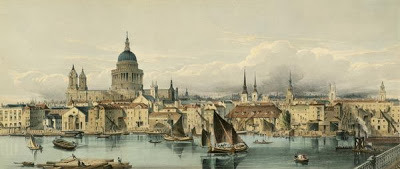 St. Paul's Cathedral from the Thames, 1850 The Wellington Tour will visit St. Paul's Cathedral on September 6, 2014, to pay our respects to the burial site of the Duke of Wellington...and there will be plenty more to see. Please consider joining Kristine and me, Victoria, in England next year. Our tour details are here.
St. Paul's Cathedral from the Thames, 1850 The Wellington Tour will visit St. Paul's Cathedral on September 6, 2014, to pay our respects to the burial site of the Duke of Wellington...and there will be plenty more to see. Please consider joining Kristine and me, Victoria, in England next year. Our tour details are here.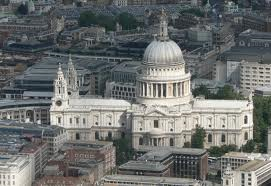 St. Paul's, Today
St. Paul's, TodaySt. Paul's is not only the mother church of the Diocese of London in the Church of England, it is a national symbol and the site of many national events: weddings, funerals, and significant celebrations.
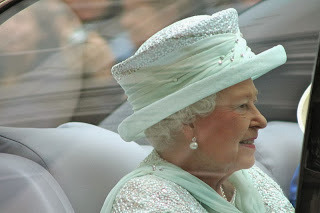 Queen Elizabeth II arrives at St. Paul's 4 June 2012
Queen Elizabeth II arrives at St. Paul's 4 June 2012It shares these roles with Westminster Abbey; St. Paul's was the site of the service of national thanksgiving to commemorate the Queen's Diamond Jubilee in 2012, and the Abbey in 2013 hosted the service of national thanksgiving to commemorate the 60th anniversary of the Queen's coronation.
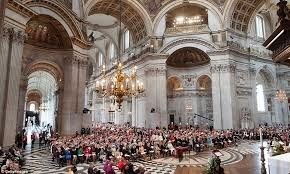 Commemoration of the Queen's Diamond Jubilee, St. Paul's, 2012
Commemoration of the Queen's Diamond Jubilee, St. Paul's, 2012For the website of the St. Paul's Cathedral, click here. You will find a dizzying round of services and events every week.
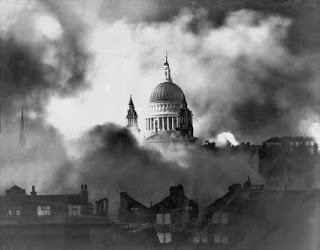 St. Paul's, a symbol of survival and hope in the Blitz Though the Cathedral suffered some damage during World War II, every morning Londoners awoke to see the dome standing tall and proud among the smoking ruins of the City. We will tell the story later of Sir Christopher Wren and building this St. Paul's from 1666-1708, probably the fifth or sixth church built on this site. The previous cathedral succumbed to the Great Fire of 1666.
St. Paul's, a symbol of survival and hope in the Blitz Though the Cathedral suffered some damage during World War II, every morning Londoners awoke to see the dome standing tall and proud among the smoking ruins of the City. We will tell the story later of Sir Christopher Wren and building this St. Paul's from 1666-1708, probably the fifth or sixth church built on this site. The previous cathedral succumbed to the Great Fire of 1666.
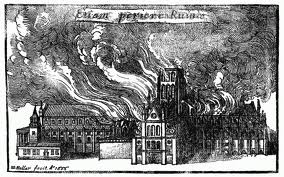 Old St. Paul's Cathedral in the Great Fire of 1666 Today, however, our post will take you to the Crypt to see the tomb of Arthur Wellesley (1769-1852), the first Duke of Wellington. He is buried near the tomb of another hero of the Napoleonic Wars, Horatio, Admiral Lord Nelson (1758-1805), who died in the victory at the Battle of Trafalgar off the Spanish Coast establishing British hegemony on the seas.
Old St. Paul's Cathedral in the Great Fire of 1666 Today, however, our post will take you to the Crypt to see the tomb of Arthur Wellesley (1769-1852), the first Duke of Wellington. He is buried near the tomb of another hero of the Napoleonic Wars, Horatio, Admiral Lord Nelson (1758-1805), who died in the victory at the Battle of Trafalgar off the Spanish Coast establishing British hegemony on the seas.
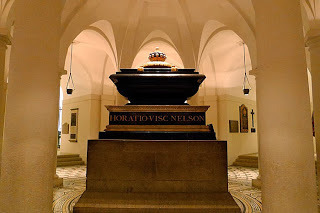 Nelson's Tomb, St. Paul's Cathedral Crypt Only one meeting between Admiral Nelson and the eleven-year younger Major-General Wellington is known. It took place in September, 1805, just six weeks before Nelson's death. The two men waited to see the Secretary of War, Lord Castlereagh. Though Wellington immediately recognized the Admiral, Nelson only after some time knew with whom he was speaking. Later, Wellington was quoted, "I don't know that I ever had a conversation that interested me more". (Andrew Lambert, [2005] Nelson: Britannia's God of War. London: Faber and Faber.)
Nelson's Tomb, St. Paul's Cathedral Crypt Only one meeting between Admiral Nelson and the eleven-year younger Major-General Wellington is known. It took place in September, 1805, just six weeks before Nelson's death. The two men waited to see the Secretary of War, Lord Castlereagh. Though Wellington immediately recognized the Admiral, Nelson only after some time knew with whom he was speaking. Later, Wellington was quoted, "I don't know that I ever had a conversation that interested me more". (Andrew Lambert, [2005] Nelson: Britannia's God of War. London: Faber and Faber.) 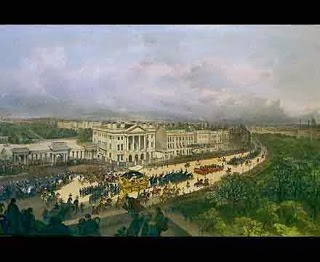 Duke of Wellington's Funeral Procession leaving Apsley House
Duke of Wellington's Funeral Procession leaving Apsley HouseThe Duke of Wellington passed away at his residence in Walmer Castle in Kent on September 14, 1852, at age 83. He was one of a very few non-royals to have a state funeral, held at St. Paul's Cathedral on November 18, 1852. More than 13,000 were in attendance, including both Houses of Parliament.
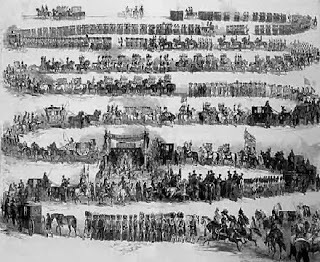 An engraving of the funeral procession
An engraving of the funeral procession
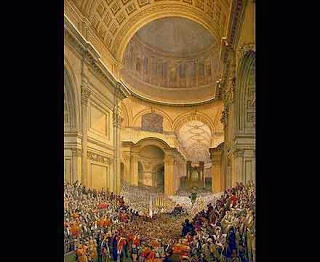 Representative view of the Wellington Funeral
Representative view of the Wellington Funeral At the proper moment in the service, the Duke's coffin was lowered into the crypt; the tomb was completed in 1858 by Architect Francis C. Penrose.
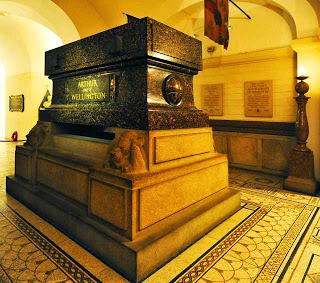
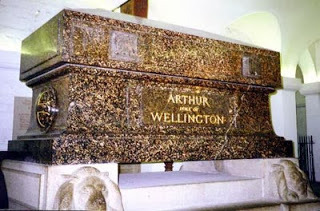
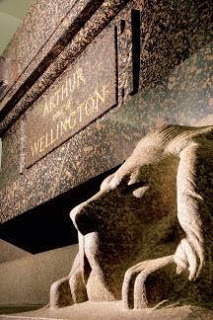 Views of the Wellington Tomb
Views of the Wellington TombNot only military heroes are buried in the crypt of St. Paul's Cathedral. Among many others buried here are the founder of British nursing Florence Nightingale (1820-1910), composer Sir Arthur Sullivan (1842-1900), painter Sir Joshua Reynolds (1723-1792), scientist Sir Arthur Fleming (1881-1955), and Sculptor Henry Moore (1898-1986).
Also in the crypt is the tomb of Sir Christopher Wren (1632-1723), architect of the cathedral. His epitaph, in Latin: 'Reader, if you seek his monument, look around you.'
Please join us to tour St. Paul's and many more wonderful sites in London and southern England on The Wellington Tour.
Published on November 15, 2013 00:30
November 13, 2013
One The Shelf - Jeeves And The Wedding Bells
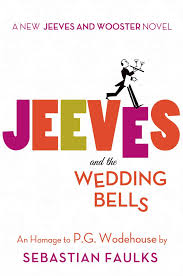
Author Sebastian Faulks was approached to write a sequel to the Jeeves and Wooster books of P.G. Wodehouse by the Wodehouse estate, which emphatically maintained since the announcement was first made that the story would be “faithful to the history and personality of Wodehouse’s characters.” Even so, as one who has read and relished these books for years, I have to say that I began this new installment with more than a modicum of doubt as to whether Faulks could pull this off. These were, after all, big shoes to fill, whether they belong to employer or valet. Anticipating the state of his reader's minds, Faulks addresses these doubts in his Author's Note, saying at the outset, "What I tried . . . to do was give people who haven't read the Jeeves books a sense of what they sound like; while for those who know them well I tried to provide a nostalgic variation - in which a memory of the real thing provides the tune and these pages perhaps a line of harmony."
In keeping with the musical metaphors, I'll tell you now that Jeeves and the Wedding Bells was a well played comic concert worthy of not a few well timed guffaws. It was delightful to find Jeeves and Wooster in a new storyline after all this time. New might not be the proper word; after all, Wodehouse himself employed several tried and true plot devices that became recurring threads in several books - bright young things getting engaged, bright young things falling out with their intended mates short of the altar, Bertie being buttonholed into patching things up between the lovers, Jeeves sorting out the results of Bertie's mucking about, hidden identities, Aunt Agatha, cash strapped aristocrats and the appearance of at least one stately pile. All of these, and the Drones Club, make welcomed reappearances in Jeeves and the Wedding Bells, in which we find Bertie and Jeeves swapping roles - Jeeves assumes the identity of Lord Etringham, while Bertie pretends to be Jeeves’ manservant Wilberforce as they wend their way down to Sir Henry Hackwood's Melbury Hall in Dorset so that Bertie can help a pal with affairs of the heart. . Note: Georgina Meadowes, to whom Bertie recently lost his own heart whilst in Cannes, is also in residence. And is engaged to someone other than the Wooster chappie.
Now that we've got all of our Wodehousian ducks in a demented row, here's an excerpt from Jeeves and the Wedding Bells at the point where Bertie gets his first glimpse of Melbury Hall: "I am something of a connoisseur of the country pile and I must say old Sir Henry had done himself remarkably well. At a guess I would say it was from the reign of Queen Anne and had been bunged up by a bewigged ancestor awash with loot from the War of the Spanish Succession or some such lucrative away fixture. This ancient Hackwood had stinted himself on neither grounds nor messuages. The ensemble reached as far as the eye could see, taking in deer park, cricket pitch, lawns and meadows as well as walled kitchen gardens and a stable block that could have quartered the Household Cavalry. The staff needed for such a place must have drawn on every household in Kingston St. Giles and I could see that whoever signed the yearly cheque to the electricity company would need a tumblerful of something strong to nerve him for the task."
Not too shabby, what? This Faulks fellow seems to have gotten the tone right. In fact, his Bertie Wooster seems a tad less dim than he tended to come across in Wodehouse's original books. Some, in other reviews, have complained about this slight deviation. However, it's my belief that Bertie simply had to evolve over time, even if that time were just a month, or even a year, in the imagniary world of P.G. Wodehouse. How often can one have the same tricks played upon their person without ever coming out the wiser? Dare we say that there's a time in every clubman's life when he's simply got to get with it?
The reader might also notice just the slightest variation in Bertie's interactions with the beloved and all knowing Jeeves, but this does not dim the cadence of their conversations. Here's a sample of the dialogue that comes just before Bertie is set to wait at table at dinner at Melbury Hall that night. Bertie is concerned that his cover will be blown by being in such close proximity to the inhabitants of the house:
"It is a fact of life, sir," he said, "that in the course of a large dinner party those at table barely notice those who wait on them."
"Unless they make an ass of themselves."
"Indeed, sir. Otherwise, the company tends to take the service for granted and to be absorbed in its own conversation."
"That sounds a bit ungrateful."
"It is the way of the world, sir, and not ours to question. Might I for instance ask you who waited on you last time you stayed at Brinkley Court?"
"Seppings?"
"No, sir. Mr. Seppings was indisposed. It was Mr. Easton, a young man from the village."
"I didn't notice."
"Exactly, sir."
I pondered this for a moment. "It's still a blood-curdling prospect."
"I understand your trepidation, sir. Remember, however, that your disguise has been unremarked thus far. Then, to make assurance doubly sure, as it were, it might be advisable to alter your appearance in some small way."
"A false beard?"
"No, sir. The footman you are replacing -"
"Hoad? The gargoyle?"
"Mr. Hoad also has a pair of side-whiskers."
"Are you saying the whiskers naturally go with the cork-screw and the folded white napkin?"
"They are more frequently worn by the serving classes, sir."
There are times to take offence, but this was not one of them. I left my high horse unmounted - though tethered pretty close. "What else?"
"If you were to part your hair centrally, sir . . . It is surprising how much difference such a small alteration can make."
"Anything further? An eyepatch? A kilt and sporran?"
"Nothing so drastic, sir. I think that if you were to wear my reading glasses for the evening the disguise would be complete without being histrionic."
As you can see, the game is again afoot. I suggest that you refrain from peeking at any further reviews before reading Jeeves and the Wedding Bells lest the handful of nitpickers poison your mind against this enjoyable effort by Mr. Faulks, who is emphatically not P.G. Wodehouse. Wodehouse is dead. Faulks is alive. So are Bertie and Jeeves. Enjoy.
 Author Sebastian Faulks ISBN-10: 1250047595 - Hardcover $14.94Publisher: St. Martin's Press (November 5, 2013), 256 pages
Author Sebastian Faulks ISBN-10: 1250047595 - Hardcover $14.94Publisher: St. Martin's Press (November 5, 2013), 256 pages
Published on November 13, 2013 00:30
November 11, 2013
Victoria Visits Apsley House (without Kristine, alas!)
I hadn't realized how little time Ed got to rest his aching foot at the Wellington Arch and walking around the neighborhood; that is, not at all.
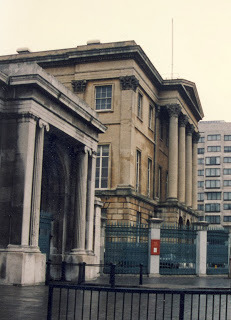 Apsley House
Apsley House
So when we got into Apsley house, he was grateful to find some chairs and tables at which one could study books on Wellington's life and accomplishments as well as the details on all the furnishings of his mansion. I did entice him away for a few minutes here and there to look at the marvelous displays around the house, but he kept migrating back to those chairs!!
I am sad to say that English Heritage, which operates Apsley House, does not allow photographs -- ages ago, when I visited while the house was operated by another group (the V and A?) with my sister-in-law, Pat, we took several pictures.
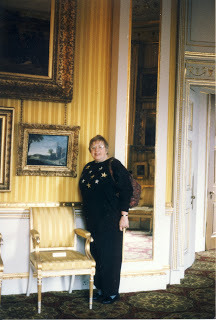 Long ago, in Apsley House
Long ago, in Apsley House
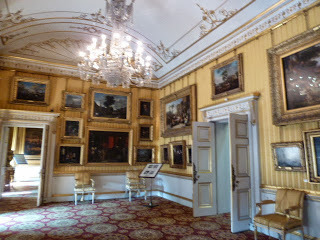 Long ago, in Apsley House
Long ago, in Apsley House
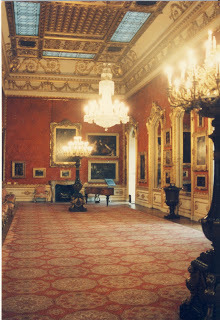 The Waterloo Gallery, Pat's photo Regardless of the lack of picture-taking, I always enjoy visiting Apsley House. There is so much to see, you need several visits to absorb it all.
The Waterloo Gallery, Pat's photo Regardless of the lack of picture-taking, I always enjoy visiting Apsley House. There is so much to see, you need several visits to absorb it all.
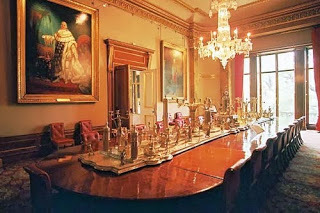
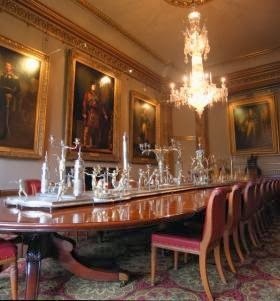
Above are two views of the elaborate Portuguese silver service on the dining table. Kristine has reported about her adventure with it when very dusty...to read about it, click here. Scroll down. She also relates great info on the house.
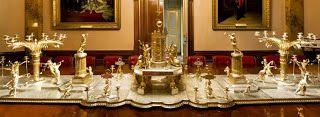 Who would leave such a wonder undusted?? The silver service is 26 feet long and three feet wide; it was presented to the Duke in 1816 by the Portuguese Council of Regency. Designed by D. A. de Sequeira, the service was made in the Military Arsenal in Lisbon from 1812 to 1816. The center group represents the Four Continents paying tribute to the armies of Britain, Portugal and Spain.
Who would leave such a wonder undusted?? The silver service is 26 feet long and three feet wide; it was presented to the Duke in 1816 by the Portuguese Council of Regency. Designed by D. A. de Sequeira, the service was made in the Military Arsenal in Lisbon from 1812 to 1816. The center group represents the Four Continents paying tribute to the armies of Britain, Portugal and Spain.
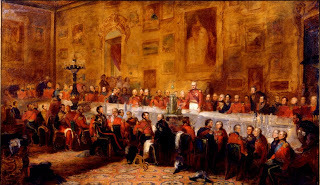 The Waterloo Banquet, 1836, by Artist William Salter (1804-1875) Salter wanted to portray the annual banquet on June 18 at Aspley House and got the assistance of the Duke's niece, Priscilla, Lady Burghersh (later, Countess of Westmorland). Once the Waterloo hero was convinced, he gave Salter access to the house and its contents. Many of his studies for the 83 people pictured can be found in the National Portrait Gallery, off Trafalgar Square. A guide to the identities is also found at Apsley House.
The Waterloo Banquet, 1836, by Artist William Salter (1804-1875) Salter wanted to portray the annual banquet on June 18 at Aspley House and got the assistance of the Duke's niece, Priscilla, Lady Burghersh (later, Countess of Westmorland). Once the Waterloo hero was convinced, he gave Salter access to the house and its contents. Many of his studies for the 83 people pictured can be found in the National Portrait Gallery, off Trafalgar Square. A guide to the identities is also found at Apsley House.
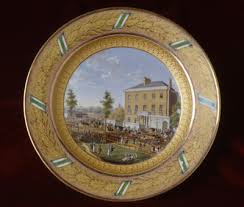 Apsley House on plate from the Saxon Service of Meissen porcelain, ca. 1818 There are several rooms of cases displaying all the gifts given to the Duke. Below, our conversation.
Apsley House on plate from the Saxon Service of Meissen porcelain, ca. 1818 There are several rooms of cases displaying all the gifts given to the Duke. Below, our conversation.
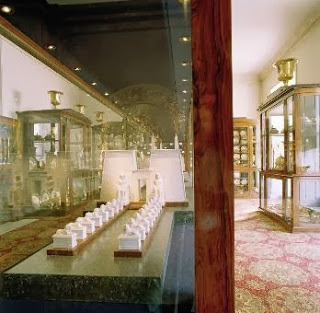 rosewood showcases of china and plate Me: "All these gifts were given to the Duke of Wellington, many by the governments of the Allies, in gratitude for his victory over Napoleon." Ed: "Oh." Me: "He received tureens and candelabra of silver, shields, vases, china services for hundreds, centerpieces and epergnes, not to mention elaborate military decorations...blah, blah, blah..." Ed: "Oh." Me: "Swords, and scabbards, medals and jewels, etc. etc...." Ed: "Can I go sit down again now?" Do you think he was a bit bored by the cases of china, silver and gilt? What I was really waiting for was his reaction to the Canova sculpture. We had traveled to Waterloo for the battlefield reenactment a few years before, and Ed was quite familiar with the popular images of Napoleon as short and stout. So when we came to the staircase, I looked for a reaction of shock -- and I was not disappointed.
rosewood showcases of china and plate Me: "All these gifts were given to the Duke of Wellington, many by the governments of the Allies, in gratitude for his victory over Napoleon." Ed: "Oh." Me: "He received tureens and candelabra of silver, shields, vases, china services for hundreds, centerpieces and epergnes, not to mention elaborate military decorations...blah, blah, blah..." Ed: "Oh." Me: "Swords, and scabbards, medals and jewels, etc. etc...." Ed: "Can I go sit down again now?" Do you think he was a bit bored by the cases of china, silver and gilt? What I was really waiting for was his reaction to the Canova sculpture. We had traveled to Waterloo for the battlefield reenactment a few years before, and Ed was quite familiar with the popular images of Napoleon as short and stout. So when we came to the staircase, I looked for a reaction of shock -- and I was not disappointed.
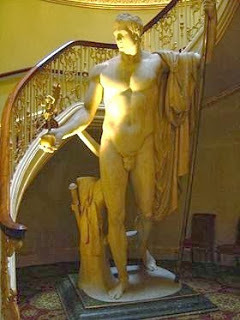 Napoleon, sculpted by Canova, 1806 Obviously Canova portrayed Napoleon as the Emperor WANTED to appear! Except that Napoleon never liked the statue, saying it lacked dignity. This monumental sculpture, standing eleven feet and four inches, was installed in Apsley House in 1817. Ed got quite a laugh out of the fanciful figure, never anyone's idea of what Napoleon looked like. Imagine the surprise of the artist Canova when it was rejected instead of accepted as a reasonable, if flattering, likeness. THEN he (Ed) went back to grab a chair. Kristine and I can hardly get enough of these lovely things, and that is not to mention the extensive collection of paintings on the walls of every room. But our husbands were definitely less than entranced. More information about objects in the Apsley House collections associated with the peninsular war, click here.
Napoleon, sculpted by Canova, 1806 Obviously Canova portrayed Napoleon as the Emperor WANTED to appear! Except that Napoleon never liked the statue, saying it lacked dignity. This monumental sculpture, standing eleven feet and four inches, was installed in Apsley House in 1817. Ed got quite a laugh out of the fanciful figure, never anyone's idea of what Napoleon looked like. Imagine the surprise of the artist Canova when it was rejected instead of accepted as a reasonable, if flattering, likeness. THEN he (Ed) went back to grab a chair. Kristine and I can hardly get enough of these lovely things, and that is not to mention the extensive collection of paintings on the walls of every room. But our husbands were definitely less than entranced. More information about objects in the Apsley House collections associated with the peninsular war, click here.
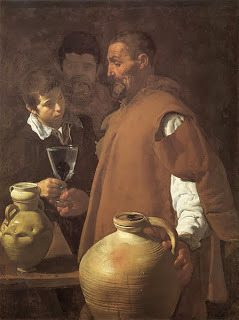 The Waterseller of Seville, ca. 1620 by Diego Velazquez (1599-`660) Hanging in Apsley House are several hundred paintings, many of which were once in the Spanish Royal Collection. Joseph Bonaparte had removed them from Madrid's royal palaces and their transport wagons were captured by Wellington's troops in 1813. Though Wellington offered to return them, the restored Spanish government refused, eventually writing to the Duke in 1816: "His Majesty, touched by your delicacy, does not wish to deprive you of that which has come into your possession by means as just as they are honourable." The collection includes works by Brueghel, Velasquez, Rubens, and Van Dyck. An excellent catalogue of the Apsley House paintings and their history can be found here.
The Waterseller of Seville, ca. 1620 by Diego Velazquez (1599-`660) Hanging in Apsley House are several hundred paintings, many of which were once in the Spanish Royal Collection. Joseph Bonaparte had removed them from Madrid's royal palaces and their transport wagons were captured by Wellington's troops in 1813. Though Wellington offered to return them, the restored Spanish government refused, eventually writing to the Duke in 1816: "His Majesty, touched by your delicacy, does not wish to deprive you of that which has come into your possession by means as just as they are honourable." The collection includes works by Brueghel, Velasquez, Rubens, and Van Dyck. An excellent catalogue of the Apsley House paintings and their history can be found here.
It is said that the Duke did not care for Equestrian Portrait by Francisco Goya, and did not hang it in Apsley House. It was at his country home, Stratfield Saye, in Hampshire until 1948 when it was hung at Apsley House. It is large, 294 x 241 cm, that's almost 10 x 8 feet. Art historians have noted that the portrait is sketchy in nature, almost as though it was unfinished. In fact it was done in a period of three weeks in Madrid from 12 August to 2 September 1812. Contemporary x-rays reveal it was painted over a previous figure in a large hat, perhaps even Wellington's enemy, Joseph Bonaparte, elder brother of the emperor and for about four years, King of Spain.
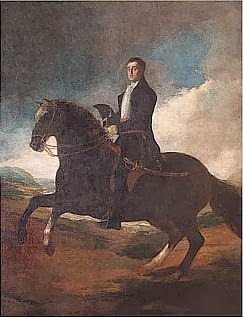 Goya: Equestrian Portrait of the Duke of Wellington, 1812English Heritage, Apsley House
Goya: Equestrian Portrait of the Duke of Wellington, 1812English Heritage, Apsley House
The portrait below, famous even though disliked by many prominent Wellington aficionados, including my distinguished colleague, was painted by Goya in 1812-14. The faces on both paintings are very similar.
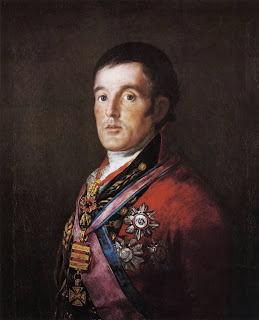 Goya: Portrait of the Duke of Wellington, National Gallery For the fascinating story of its convoluted purchase, theft from the National Gallery and the HEA (happy ever after), read Kristine's account, here. We look forward to sharing our tour of Apsley House with you on The Wellington Tour, 4-14 September, 2014. Click the link for complete for details,
Goya: Portrait of the Duke of Wellington, National Gallery For the fascinating story of its convoluted purchase, theft from the National Gallery and the HEA (happy ever after), read Kristine's account, here. We look forward to sharing our tour of Apsley House with you on The Wellington Tour, 4-14 September, 2014. Click the link for complete for details,
 Apsley House
Apsley HouseSo when we got into Apsley house, he was grateful to find some chairs and tables at which one could study books on Wellington's life and accomplishments as well as the details on all the furnishings of his mansion. I did entice him away for a few minutes here and there to look at the marvelous displays around the house, but he kept migrating back to those chairs!!
I am sad to say that English Heritage, which operates Apsley House, does not allow photographs -- ages ago, when I visited while the house was operated by another group (the V and A?) with my sister-in-law, Pat, we took several pictures.
 Long ago, in Apsley House
Long ago, in Apsley House
 Long ago, in Apsley House
Long ago, in Apsley House
 The Waterloo Gallery, Pat's photo Regardless of the lack of picture-taking, I always enjoy visiting Apsley House. There is so much to see, you need several visits to absorb it all.
The Waterloo Gallery, Pat's photo Regardless of the lack of picture-taking, I always enjoy visiting Apsley House. There is so much to see, you need several visits to absorb it all.


Above are two views of the elaborate Portuguese silver service on the dining table. Kristine has reported about her adventure with it when very dusty...to read about it, click here. Scroll down. She also relates great info on the house.
 Who would leave such a wonder undusted?? The silver service is 26 feet long and three feet wide; it was presented to the Duke in 1816 by the Portuguese Council of Regency. Designed by D. A. de Sequeira, the service was made in the Military Arsenal in Lisbon from 1812 to 1816. The center group represents the Four Continents paying tribute to the armies of Britain, Portugal and Spain.
Who would leave such a wonder undusted?? The silver service is 26 feet long and three feet wide; it was presented to the Duke in 1816 by the Portuguese Council of Regency. Designed by D. A. de Sequeira, the service was made in the Military Arsenal in Lisbon from 1812 to 1816. The center group represents the Four Continents paying tribute to the armies of Britain, Portugal and Spain.
 The Waterloo Banquet, 1836, by Artist William Salter (1804-1875) Salter wanted to portray the annual banquet on June 18 at Aspley House and got the assistance of the Duke's niece, Priscilla, Lady Burghersh (later, Countess of Westmorland). Once the Waterloo hero was convinced, he gave Salter access to the house and its contents. Many of his studies for the 83 people pictured can be found in the National Portrait Gallery, off Trafalgar Square. A guide to the identities is also found at Apsley House.
The Waterloo Banquet, 1836, by Artist William Salter (1804-1875) Salter wanted to portray the annual banquet on June 18 at Aspley House and got the assistance of the Duke's niece, Priscilla, Lady Burghersh (later, Countess of Westmorland). Once the Waterloo hero was convinced, he gave Salter access to the house and its contents. Many of his studies for the 83 people pictured can be found in the National Portrait Gallery, off Trafalgar Square. A guide to the identities is also found at Apsley House.
 Apsley House on plate from the Saxon Service of Meissen porcelain, ca. 1818 There are several rooms of cases displaying all the gifts given to the Duke. Below, our conversation.
Apsley House on plate from the Saxon Service of Meissen porcelain, ca. 1818 There are several rooms of cases displaying all the gifts given to the Duke. Below, our conversation.
 rosewood showcases of china and plate Me: "All these gifts were given to the Duke of Wellington, many by the governments of the Allies, in gratitude for his victory over Napoleon." Ed: "Oh." Me: "He received tureens and candelabra of silver, shields, vases, china services for hundreds, centerpieces and epergnes, not to mention elaborate military decorations...blah, blah, blah..." Ed: "Oh." Me: "Swords, and scabbards, medals and jewels, etc. etc...." Ed: "Can I go sit down again now?" Do you think he was a bit bored by the cases of china, silver and gilt? What I was really waiting for was his reaction to the Canova sculpture. We had traveled to Waterloo for the battlefield reenactment a few years before, and Ed was quite familiar with the popular images of Napoleon as short and stout. So when we came to the staircase, I looked for a reaction of shock -- and I was not disappointed.
rosewood showcases of china and plate Me: "All these gifts were given to the Duke of Wellington, many by the governments of the Allies, in gratitude for his victory over Napoleon." Ed: "Oh." Me: "He received tureens and candelabra of silver, shields, vases, china services for hundreds, centerpieces and epergnes, not to mention elaborate military decorations...blah, blah, blah..." Ed: "Oh." Me: "Swords, and scabbards, medals and jewels, etc. etc...." Ed: "Can I go sit down again now?" Do you think he was a bit bored by the cases of china, silver and gilt? What I was really waiting for was his reaction to the Canova sculpture. We had traveled to Waterloo for the battlefield reenactment a few years before, and Ed was quite familiar with the popular images of Napoleon as short and stout. So when we came to the staircase, I looked for a reaction of shock -- and I was not disappointed.  Napoleon, sculpted by Canova, 1806 Obviously Canova portrayed Napoleon as the Emperor WANTED to appear! Except that Napoleon never liked the statue, saying it lacked dignity. This monumental sculpture, standing eleven feet and four inches, was installed in Apsley House in 1817. Ed got quite a laugh out of the fanciful figure, never anyone's idea of what Napoleon looked like. Imagine the surprise of the artist Canova when it was rejected instead of accepted as a reasonable, if flattering, likeness. THEN he (Ed) went back to grab a chair. Kristine and I can hardly get enough of these lovely things, and that is not to mention the extensive collection of paintings on the walls of every room. But our husbands were definitely less than entranced. More information about objects in the Apsley House collections associated with the peninsular war, click here.
Napoleon, sculpted by Canova, 1806 Obviously Canova portrayed Napoleon as the Emperor WANTED to appear! Except that Napoleon never liked the statue, saying it lacked dignity. This monumental sculpture, standing eleven feet and four inches, was installed in Apsley House in 1817. Ed got quite a laugh out of the fanciful figure, never anyone's idea of what Napoleon looked like. Imagine the surprise of the artist Canova when it was rejected instead of accepted as a reasonable, if flattering, likeness. THEN he (Ed) went back to grab a chair. Kristine and I can hardly get enough of these lovely things, and that is not to mention the extensive collection of paintings on the walls of every room. But our husbands were definitely less than entranced. More information about objects in the Apsley House collections associated with the peninsular war, click here.
 The Waterseller of Seville, ca. 1620 by Diego Velazquez (1599-`660) Hanging in Apsley House are several hundred paintings, many of which were once in the Spanish Royal Collection. Joseph Bonaparte had removed them from Madrid's royal palaces and their transport wagons were captured by Wellington's troops in 1813. Though Wellington offered to return them, the restored Spanish government refused, eventually writing to the Duke in 1816: "His Majesty, touched by your delicacy, does not wish to deprive you of that which has come into your possession by means as just as they are honourable." The collection includes works by Brueghel, Velasquez, Rubens, and Van Dyck. An excellent catalogue of the Apsley House paintings and their history can be found here.
The Waterseller of Seville, ca. 1620 by Diego Velazquez (1599-`660) Hanging in Apsley House are several hundred paintings, many of which were once in the Spanish Royal Collection. Joseph Bonaparte had removed them from Madrid's royal palaces and their transport wagons were captured by Wellington's troops in 1813. Though Wellington offered to return them, the restored Spanish government refused, eventually writing to the Duke in 1816: "His Majesty, touched by your delicacy, does not wish to deprive you of that which has come into your possession by means as just as they are honourable." The collection includes works by Brueghel, Velasquez, Rubens, and Van Dyck. An excellent catalogue of the Apsley House paintings and their history can be found here.It is said that the Duke did not care for Equestrian Portrait by Francisco Goya, and did not hang it in Apsley House. It was at his country home, Stratfield Saye, in Hampshire until 1948 when it was hung at Apsley House. It is large, 294 x 241 cm, that's almost 10 x 8 feet. Art historians have noted that the portrait is sketchy in nature, almost as though it was unfinished. In fact it was done in a period of three weeks in Madrid from 12 August to 2 September 1812. Contemporary x-rays reveal it was painted over a previous figure in a large hat, perhaps even Wellington's enemy, Joseph Bonaparte, elder brother of the emperor and for about four years, King of Spain.
 Goya: Equestrian Portrait of the Duke of Wellington, 1812English Heritage, Apsley House
Goya: Equestrian Portrait of the Duke of Wellington, 1812English Heritage, Apsley HouseThe portrait below, famous even though disliked by many prominent Wellington aficionados, including my distinguished colleague, was painted by Goya in 1812-14. The faces on both paintings are very similar.
 Goya: Portrait of the Duke of Wellington, National Gallery For the fascinating story of its convoluted purchase, theft from the National Gallery and the HEA (happy ever after), read Kristine's account, here. We look forward to sharing our tour of Apsley House with you on The Wellington Tour, 4-14 September, 2014. Click the link for complete for details,
Goya: Portrait of the Duke of Wellington, National Gallery For the fascinating story of its convoluted purchase, theft from the National Gallery and the HEA (happy ever after), read Kristine's account, here. We look forward to sharing our tour of Apsley House with you on The Wellington Tour, 4-14 September, 2014. Click the link for complete for details,
Published on November 11, 2013 04:51
November 8, 2013
Tripping the Light Fantastic at the Brighton Pavilion
Victoria here, about to get out my Roget's to look for synonyms for fantastic and over-the-top...for I am about to write of this incredible building.
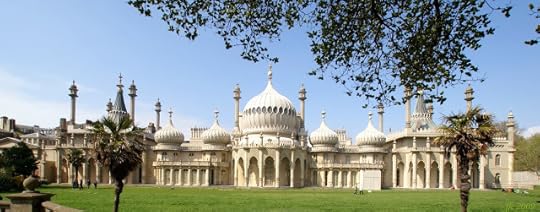 The Royal Pavilion, Brighton The Wellington Tour, planned by Kristine, Patty Suchy, and me, will visit the Pavilion on September 9, 2014. For the rest of the itinerary and all the Tour details, go to:http://wellingtontour.blogspot.com We'd love to have you join us for this and other intriguing sites. So what can one say about such a structure? In its earliest incarnation, it was a simple farmhouse in the fishing village of Brighthelmstone on the Sussex coast. In the late 18th century, the popularity of seaside spas was growing. Fashionable London came to drink the sea water and bathe in it as well. As soon as George, Prince of Wales, later Prince Regent and eventually George IV (1762-1830) came to stay, Brighton became a center of Society.
The Royal Pavilion, Brighton The Wellington Tour, planned by Kristine, Patty Suchy, and me, will visit the Pavilion on September 9, 2014. For the rest of the itinerary and all the Tour details, go to:http://wellingtontour.blogspot.com We'd love to have you join us for this and other intriguing sites. So what can one say about such a structure? In its earliest incarnation, it was a simple farmhouse in the fishing village of Brighthelmstone on the Sussex coast. In the late 18th century, the popularity of seaside spas was growing. Fashionable London came to drink the sea water and bathe in it as well. As soon as George, Prince of Wales, later Prince Regent and eventually George IV (1762-1830) came to stay, Brighton became a center of Society.
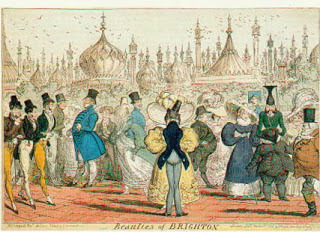
Prince George had a very high opinion of himself and his superior good taste. Au contraire! He did have taste alright, and much of it was excellent, but when it was bad, it was very, very bad. In the tradition of the Hanoverian royal family, our George and his father George III, were usually at odds in regard to almost every aspect of their lives: the King did not approve, and the more George could irritate his father, apparently the more he did it, primarily by buying and remodeling buildings, furnishing them expensively, and otherwise overspending his allowance and piling up debts.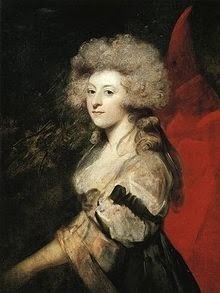 Maria Fitzherbert Not to mention Prince George's secret and illegal marriage to Maria Fitzherbert, about which his father may have known. But this is not the place to discuss the many amours and several marriages of the Prince. We've blogged about these topics before. You might try the Forgotten Queen here or George IV's ill-fated marriage, here.
Maria Fitzherbert Not to mention Prince George's secret and illegal marriage to Maria Fitzherbert, about which his father may have known. But this is not the place to discuss the many amours and several marriages of the Prince. We've blogged about these topics before. You might try the Forgotten Queen here or George IV's ill-fated marriage, here.
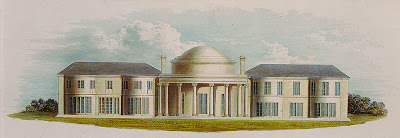 The Marine Pavilion, Brighton; as it appeared about 1790
The Marine Pavilion, Brighton; as it appeared about 1790
In the late 1780's Henry Holland, an architect who had done considerable work on the Prince's London residence, Carlton House, began transforming the farmhouse into the attractive house above. But it was not quite grandiose enough for the Prince, and before long, he chose architect John Nash, whose ideas matched the Prince's in exaggerated scope and pomposity, to further alter the Pavilion.
We told the story of Sezincote, the house that inspired the Prince's fantasies, here.
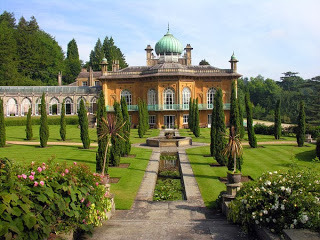 The Sezincote website is here.
The Sezincote website is here.
The exterior of the Pavilion is almost beyond description, definitely not pure Hindoo or Chinese, or any other of its supposed stimuli, but a sort of wedding-cake confection with a style all its own: domes, minarets, etc. etc. One thing is for sure: you can't ignore the Prince's pleasure palace when you drive down the Old Steine toward the sea in Brighton.
BTW, I believe the Steine or Steyne is pronounced Steen.
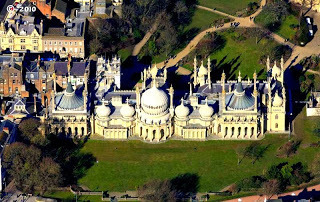 Aerial View
Aerial View
For the official website, click here. In recent years, the gardens have been restored to their original splendor, or perhaps even more so. Is that possible? Out-Georging George? In interiors are as outré as the exterior.
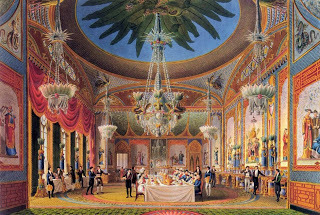 Banqueting Room, from John Nash's Views of the Royal Pavilion (1826).
Banqueting Room, from John Nash's Views of the Royal Pavilion (1826).
In the hopes that you will be able to join us at the Brighton Pavilion on the Wellington Tour next September, I will include some other views of the chinoiserie interiors, as a temptation. Pictures will never quite do justice to the feast for the eye, however.
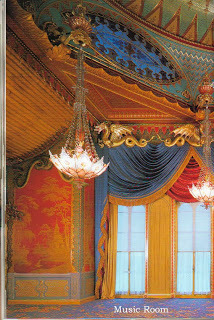 Music Room
Music Room
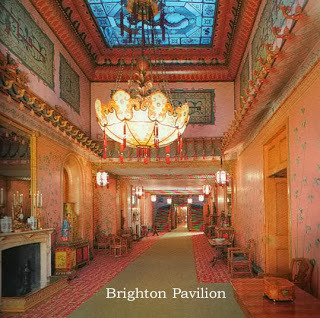 The Long Gallery
The Long Gallery
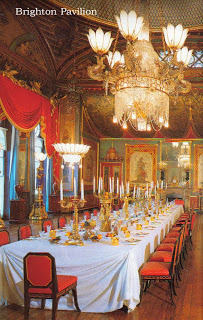 The Banqueting Room
The Banqueting Room
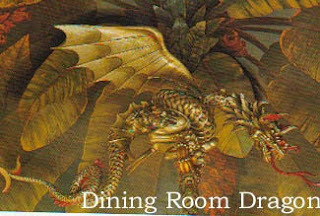 Chandelier Detail
Chandelier Detail
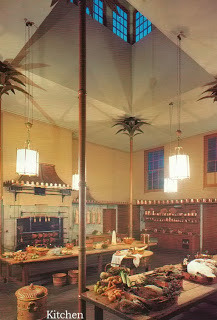 The Great Kitchen The Great Kitchen was designed with a high ceiling, for dispersal of heat and fumes, incorporated all the latest features for the creation of great banquets. For a time, it was the "kingdom" of the great chef, Antonin Carême (1784-1833), the first celebrity chef. Our pal, actor and author Ian Kelly, wrote a biography of Carême. For more information, click here.
The Great Kitchen The Great Kitchen was designed with a high ceiling, for dispersal of heat and fumes, incorporated all the latest features for the creation of great banquets. For a time, it was the "kingdom" of the great chef, Antonin Carême (1784-1833), the first celebrity chef. Our pal, actor and author Ian Kelly, wrote a biography of Carême. For more information, click here.
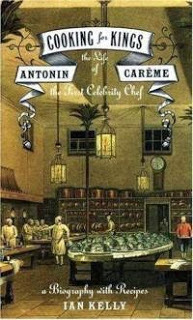
The Brighton Pavilion is now owned and operated by the City of Brighton. I suppose, after seeing the pictures above, it won't be a surprise that Queen Victoria did not find the place to her liking. She sold it to Brighton in 1850, though she kept many of the furnishings for use at Buckingham Palace and Windsor Castle. Over the years, the Pavilion has been restored and developed into a popular tourist site. Some of the furnishing have been loaned back to the Pavilion by HM The Queen.
Now here is the question, what did the Duke of Wellington think of it? The Duke was a loyal servant of the crown and he followed George IV's desires regarding the disposition of his personal effects after the King died. But one can hardly imagine that the structure appealed to the Duke's tastes any more than it did to Victoria's. Fortunately, we have an account of the Duke's reaction upon first seeing the Pavilion from the letters of Princess Lieven:
January 26, 1822 - "I wish you were here to laugh You cannot imagine how astonished the Duke of Wellington is. He had not been here before, and I thoroughly enjoyed noting the kind of remark and the kind of surprise that the whole household evokes in a newcomer. I do not believe that, since the days of Heliogabalus, there have been such magnificence and such luxury. There is something effeminate in it which is disgusting. One spends the evening half-lying on cushions; the lights are dazzling; there are perfumes, music, liquers - "Devil take me, I think I must have got into bad company." You can guess who said that, and the tone in which it was said. Here is one single detail about the establishment. To light the three rooms, used when the family is alone, costs 150 guineas an evening; when the apartment is fully opened up, it is double that."
In any case, the Duke had to spend a great deal of time in Brighton due to Royal summons, and we hope you will enjoy touring it with us.
Details regarding The Wellington Tour can be found here.
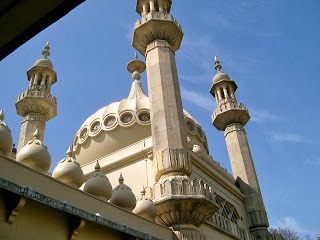
 The Royal Pavilion, Brighton The Wellington Tour, planned by Kristine, Patty Suchy, and me, will visit the Pavilion on September 9, 2014. For the rest of the itinerary and all the Tour details, go to:http://wellingtontour.blogspot.com We'd love to have you join us for this and other intriguing sites. So what can one say about such a structure? In its earliest incarnation, it was a simple farmhouse in the fishing village of Brighthelmstone on the Sussex coast. In the late 18th century, the popularity of seaside spas was growing. Fashionable London came to drink the sea water and bathe in it as well. As soon as George, Prince of Wales, later Prince Regent and eventually George IV (1762-1830) came to stay, Brighton became a center of Society.
The Royal Pavilion, Brighton The Wellington Tour, planned by Kristine, Patty Suchy, and me, will visit the Pavilion on September 9, 2014. For the rest of the itinerary and all the Tour details, go to:http://wellingtontour.blogspot.com We'd love to have you join us for this and other intriguing sites. So what can one say about such a structure? In its earliest incarnation, it was a simple farmhouse in the fishing village of Brighthelmstone on the Sussex coast. In the late 18th century, the popularity of seaside spas was growing. Fashionable London came to drink the sea water and bathe in it as well. As soon as George, Prince of Wales, later Prince Regent and eventually George IV (1762-1830) came to stay, Brighton became a center of Society.

Prince George had a very high opinion of himself and his superior good taste. Au contraire! He did have taste alright, and much of it was excellent, but when it was bad, it was very, very bad. In the tradition of the Hanoverian royal family, our George and his father George III, were usually at odds in regard to almost every aspect of their lives: the King did not approve, and the more George could irritate his father, apparently the more he did it, primarily by buying and remodeling buildings, furnishing them expensively, and otherwise overspending his allowance and piling up debts.
 Maria Fitzherbert Not to mention Prince George's secret and illegal marriage to Maria Fitzherbert, about which his father may have known. But this is not the place to discuss the many amours and several marriages of the Prince. We've blogged about these topics before. You might try the Forgotten Queen here or George IV's ill-fated marriage, here.
Maria Fitzherbert Not to mention Prince George's secret and illegal marriage to Maria Fitzherbert, about which his father may have known. But this is not the place to discuss the many amours and several marriages of the Prince. We've blogged about these topics before. You might try the Forgotten Queen here or George IV's ill-fated marriage, here. The Marine Pavilion, Brighton; as it appeared about 1790
The Marine Pavilion, Brighton; as it appeared about 1790 In the late 1780's Henry Holland, an architect who had done considerable work on the Prince's London residence, Carlton House, began transforming the farmhouse into the attractive house above. But it was not quite grandiose enough for the Prince, and before long, he chose architect John Nash, whose ideas matched the Prince's in exaggerated scope and pomposity, to further alter the Pavilion.
We told the story of Sezincote, the house that inspired the Prince's fantasies, here.
 The Sezincote website is here.
The Sezincote website is here.The exterior of the Pavilion is almost beyond description, definitely not pure Hindoo or Chinese, or any other of its supposed stimuli, but a sort of wedding-cake confection with a style all its own: domes, minarets, etc. etc. One thing is for sure: you can't ignore the Prince's pleasure palace when you drive down the Old Steine toward the sea in Brighton.
BTW, I believe the Steine or Steyne is pronounced Steen.
 Aerial View
Aerial ViewFor the official website, click here. In recent years, the gardens have been restored to their original splendor, or perhaps even more so. Is that possible? Out-Georging George? In interiors are as outré as the exterior.
 Banqueting Room, from John Nash's Views of the Royal Pavilion (1826).
Banqueting Room, from John Nash's Views of the Royal Pavilion (1826).In the hopes that you will be able to join us at the Brighton Pavilion on the Wellington Tour next September, I will include some other views of the chinoiserie interiors, as a temptation. Pictures will never quite do justice to the feast for the eye, however.
 Music Room
Music Room
 The Long Gallery
The Long Gallery
 The Banqueting Room
The Banqueting Room
 Chandelier Detail
Chandelier Detail
 The Great Kitchen The Great Kitchen was designed with a high ceiling, for dispersal of heat and fumes, incorporated all the latest features for the creation of great banquets. For a time, it was the "kingdom" of the great chef, Antonin Carême (1784-1833), the first celebrity chef. Our pal, actor and author Ian Kelly, wrote a biography of Carême. For more information, click here.
The Great Kitchen The Great Kitchen was designed with a high ceiling, for dispersal of heat and fumes, incorporated all the latest features for the creation of great banquets. For a time, it was the "kingdom" of the great chef, Antonin Carême (1784-1833), the first celebrity chef. Our pal, actor and author Ian Kelly, wrote a biography of Carême. For more information, click here.

The Brighton Pavilion is now owned and operated by the City of Brighton. I suppose, after seeing the pictures above, it won't be a surprise that Queen Victoria did not find the place to her liking. She sold it to Brighton in 1850, though she kept many of the furnishings for use at Buckingham Palace and Windsor Castle. Over the years, the Pavilion has been restored and developed into a popular tourist site. Some of the furnishing have been loaned back to the Pavilion by HM The Queen.
Now here is the question, what did the Duke of Wellington think of it? The Duke was a loyal servant of the crown and he followed George IV's desires regarding the disposition of his personal effects after the King died. But one can hardly imagine that the structure appealed to the Duke's tastes any more than it did to Victoria's. Fortunately, we have an account of the Duke's reaction upon first seeing the Pavilion from the letters of Princess Lieven:
January 26, 1822 - "I wish you were here to laugh You cannot imagine how astonished the Duke of Wellington is. He had not been here before, and I thoroughly enjoyed noting the kind of remark and the kind of surprise that the whole household evokes in a newcomer. I do not believe that, since the days of Heliogabalus, there have been such magnificence and such luxury. There is something effeminate in it which is disgusting. One spends the evening half-lying on cushions; the lights are dazzling; there are perfumes, music, liquers - "Devil take me, I think I must have got into bad company." You can guess who said that, and the tone in which it was said. Here is one single detail about the establishment. To light the three rooms, used when the family is alone, costs 150 guineas an evening; when the apartment is fully opened up, it is double that."
In any case, the Duke had to spend a great deal of time in Brighton due to Royal summons, and we hope you will enjoy touring it with us.
Details regarding The Wellington Tour can be found here.

Published on November 08, 2013 00:30
November 6, 2013
The British Southern Belle?
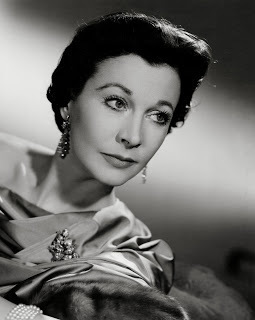
By Guest Blogger Spencer Blohm
The Oscar winning actress Vivien Leigh, famous for her roles as Scarlett O’Hara in Gone with the Wind and Blanche DuBois in A Streetcar Named Desire, would have turned 100 on Nov. 5. Despite her convincing and famous performances as a Southern Belle, Vivien was actually born in British India and spent a majority of her life living in London. Let’s take a look back at the life and legacy of one of England’s finest actresses.
Vivian Mary Hartley was born on November 5, 1913 in Darjeeling, British India to an English member of the Indian Cavalry and an Irish and Parsee-Indian mother. At the age of six, she was sent to attend the Convent of the Sacred Heart in Roehampton where she formed a friendship with another future actress, Maureen O’Sullivan. She then spent a few years attending various schools across Europe as she travelled with her father. Upon her return to England, she began her schooling at the Royal Academy of Dramatic Art. During this time she met and married Herbert Leigh Holman in 1931 and in 1933 gave birth to her daughter, Suzanne.
Shortly thereafter she began her acting career and changed her name to Vivien Leigh. To her dismay she wasn’t deemed talented enough by her agent to do film, so she began her career on the stage. Shortly after her acting debut she starred in the 1937 play Fire Over England with Laurence Olivier. Their chemistry on stage translated off, and the two began an affair. They soon fell in love and moved in together despite the fact that neither one of their spouses would grant them a divorce.
In 1938, the search for a Scarlett O’Hara had swept up Hollywood, and most of its actresses, in a tizzy of excitement. Vivien approached her agent and asked for his permission to play Scarlett, to which he replied that she was far too British to ever pass off being a Southern belle. However, she packed her bags for Hollywood to both visit Olivier and also attempt to get the part. Her audition and screen test were a hit and she won the role of a lifetime. However, her frequent clashes with both director Victor Fleming and her costar Leslie Howard took its toll on her, as signs of her notorious manic behavior first began to appear.
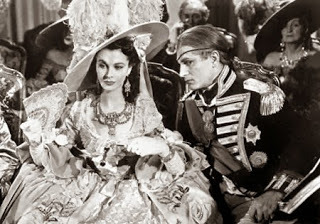 She was able to finally marry Olivier in August of 1940 after both of their spouses agreed to divorce. That same year, she was a certified Hollywood star after the release of her critically and commercially successful film, Waterloo Bridge. Vivien and Olivier then starred in the thinly veiled pro-British propaganda film The Hamilton Woman (photo above), which was meant to stir pro-British sentiment among Americans. The film was favored by Winston Churchill, who became close personal friends with the couple. For her part in the war efforts, Vivien toured North Africa during 1943, performing for the allied troops before falling ill with tuberculosis.
She was able to finally marry Olivier in August of 1940 after both of their spouses agreed to divorce. That same year, she was a certified Hollywood star after the release of her critically and commercially successful film, Waterloo Bridge. Vivien and Olivier then starred in the thinly veiled pro-British propaganda film The Hamilton Woman (photo above), which was meant to stir pro-British sentiment among Americans. The film was favored by Winston Churchill, who became close personal friends with the couple. For her part in the war efforts, Vivien toured North Africa during 1943, performing for the allied troops before falling ill with tuberculosis.Following a miscarriage in 1945 while filming Caesar and Cleopatra, Vivien’s bipolar disorder revealed itself to her husband, who was often the victim of her violent verbal and physical attacks. Following this, the couple began a theatrical tour in Australia and New Zealand where tensions among the couple rose as they were driven to the point of exhaustion by their schedule. However, upon her return to England, Vivien was cast in the West End production of A Streetcar Named Desire as Blanche DuBois (photo below). Soon after the play had finished its run, she was cast in the film adaptation in the same role. She earned rave reviews for her acting and secured her second Academy Award as well as a BAFTA.
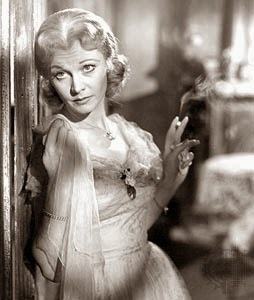
In 1953, she took a role in the film Elephant Walk with Peter Finch. The two began an affair, and shortly after filming began Vivien suffered a mental breakdown and had to withdraw from the film. Her recovery took several months, during which she began working on the stage again with Laurence. However, in 1956 she suffered a second miscarriage which plunged her into a depression which lasted for months. It was during this period that her marriage to Olivier fell apart and by 1960 the couple had divorced. In his memoirs, Olivier discussed the toll that Vivien’s bipolar disorder took on their marriage and how it ultimately lead to its demise.
By this point she had started a relationship with actor Jack Merivale (photo below). Their relationship proved to be a calming one for Vivien, who was still enjoying success on the international theater circuit. In 1963, she won a Tony Award for her role in the musical Tovarich. She continued to balance her stage roles with film roles during the mid 60’s before she suffered from another bout of tuberculosis in 1967. She was found dead in her home by Merivale on July 7, 1967 after her lungs had collapsed.
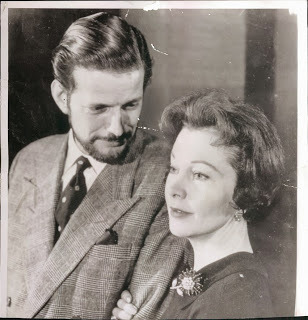
Vivien was cremated and her ashes were scattered on the lake at her house near Blackboys, East Sussex. Her legacy lives on through the impressive body of work she produced and her incredible beauty. Although she was the perfect image of an English lady, she will always be remembered for her most successful screen roles as strong Southern belles.
About the Author: Spencer Blohm is a freelance entertainment, fashion, culture, and lifestyle author for SatelliteStarInternet.com. Despite his fascination with Old Hollywood even he was surprised that the ultimate Southern belle, Ms. Leigh, was in fact a Brit! He lives and works in Chicago where he is still mad at Scarlett for not getting of the stairs and chasing Rhett.
Published on November 06, 2013 00:00
November 4, 2013
Victoria Visits the Wellington Arch
When we returned to London from our three-day trip -- one each in Cambridge, at Houghton Hall, and at Holkham Hall, I had a busy agenda for the remaining few days of our trip. Poor hubby Ed suffered every day from that very sore foot, aching now in addition to blisters, scrapes and -- well, you get the picture. I always gave him the option of staying put at the hotel, but he stoically limped onward.
Despite the fact that I had visited Apsley House several times, with Kristine, with Pat, my sister-in-law, and others, Ed had never been there. So that was second on my list, just behind the Wellington Arch, which I'd never visited. I'd walked past it plenty of times, but it had not been open before. A bit of web checking told me that the Arch recently opened exhibition space, at that time devoted to a study of the many past and current attempt to SAVE British heritage, particularly by protecting buildings and open spaces.
The Wellington Arch website is here.
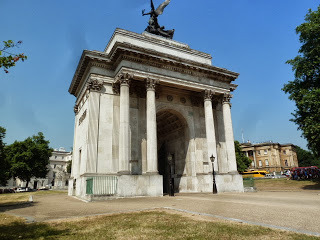
Soapbox alert!!! It doesn't take much beyond a glance at the London skyline to see how contemporary skyscrapers overpower and almost obliterate the beautiful early 20th century view of St. Paul's Dome and the many graceful steeples and spires. Okay, call me a traditionalist (Guilty!) but I wish the powers-that-be could have kept the tall buildings in groups away from the City, Mayfair and Westminster. Alas, it is far too late.
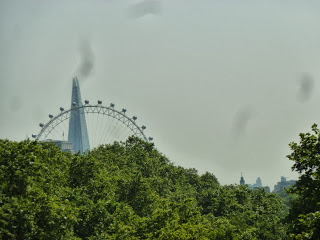 View from the Wellington Arch (including a few stray smudges) I have nothing against tall buildings -- I live in one. But if they had been clustered in various neighborhoods away from the center of London, the beautiful skyline would have been preserved. True of a few cities, Washington, D C for example. No high rises downtown, all clustered in the surrounding communities to preserve the views of the Capitol and other monuments. End of soapbox. Please resume your usual activities.
View from the Wellington Arch (including a few stray smudges) I have nothing against tall buildings -- I live in one. But if they had been clustered in various neighborhoods away from the center of London, the beautiful skyline would have been preserved. True of a few cities, Washington, D C for example. No high rises downtown, all clustered in the surrounding communities to preserve the views of the Capitol and other monuments. End of soapbox. Please resume your usual activities.
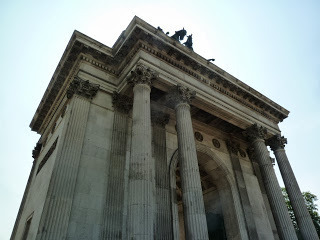 At the height of the Roman Empire, triumphal arches were built to commemorate great events. Think of Rome's Arch of Constantine, the Arch of Titus, and so on. The French started building one in 1806 to mark Napoleon's victory in the Battle of Austerlitz, but it remained unfinished for thirty years, now known as the Arc de Triomphe de l'Etoile in Paris. Not to be outdone, the Prince Regent, later King George IV, wanted to memorialize British victory over France..
At the height of the Roman Empire, triumphal arches were built to commemorate great events. Think of Rome's Arch of Constantine, the Arch of Titus, and so on. The French started building one in 1806 to mark Napoleon's victory in the Battle of Austerlitz, but it remained unfinished for thirty years, now known as the Arc de Triomphe de l'Etoile in Paris. Not to be outdone, the Prince Regent, later King George IV, wanted to memorialize British victory over France..
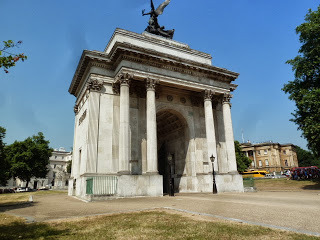 Wellington Arch; Apsley House at the far right Both the Wellington Arch (aka the Green Park Arch and the Constitution Arch) and the Marble Arch were affected by political arguments over cost, design and placement in the 19th century. Both were moved from their original positions and both stand relatively isolated in the middle of traffic circles surrounded by buses, autos, lorries and other noisy vehicles. Traffic too often trumps landscape. Whoops, soapbox again.
Wellington Arch; Apsley House at the far right Both the Wellington Arch (aka the Green Park Arch and the Constitution Arch) and the Marble Arch were affected by political arguments over cost, design and placement in the 19th century. Both were moved from their original positions and both stand relatively isolated in the middle of traffic circles surrounded by buses, autos, lorries and other noisy vehicles. Traffic too often trumps landscape. Whoops, soapbox again.
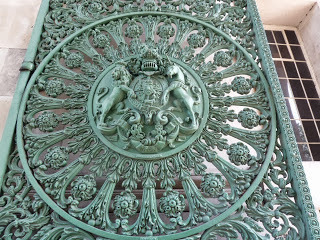 One of the gates, cast in iron by Joseph Bramah and Sons, restored recently The Wellington Arch was designed by Architect Decimus Burton (1800-1881), as his name indicates, the tenth child in his family. He worked with his father, also an architect and John Nash as well. He also designed the Hyde Park screen next to Apsley House.
One of the gates, cast in iron by Joseph Bramah and Sons, restored recently The Wellington Arch was designed by Architect Decimus Burton (1800-1881), as his name indicates, the tenth child in his family. He worked with his father, also an architect and John Nash as well. He also designed the Hyde Park screen next to Apsley House.
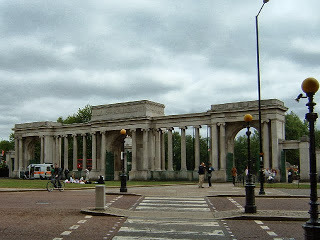 The Hyde Park Screen, 1825
The Hyde Park Screen, 1825
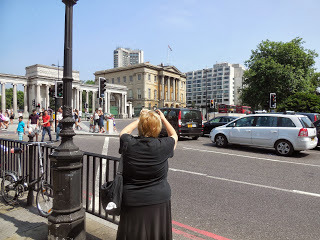 This picture shows the screen in relation to Apsley House; the Wellington is Arch off the picture to the right A few years ago, English Heritage took over the Wellington Arch and changed it from a small police into to a small gift shop with an exhibition space above. There is access to the viewing balcony at the top as well, all by elevator. Ed's sore foot appreciated that particularly!
This picture shows the screen in relation to Apsley House; the Wellington is Arch off the picture to the right A few years ago, English Heritage took over the Wellington Arch and changed it from a small police into to a small gift shop with an exhibition space above. There is access to the viewing balcony at the top as well, all by elevator. Ed's sore foot appreciated that particularly!
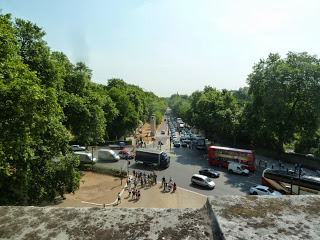 View down Constitution Hill towards Buckingham Palace
View down Constitution Hill towards Buckingham Palace
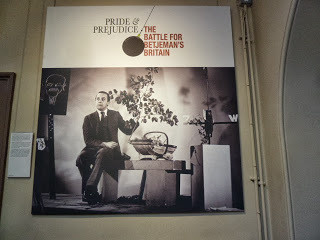 The Exhibition: Pride and Prejudice: The Battle for Betjeman's Britain John Betjeman (1906-1984) was Britain's Poet Laureate in addition to being a popular radio and tv commentator and an avid campaigner for the protection of architectural heritage. Below, the maquette for his statue located in St. Pancras Station, one of the buildings he successfully fought to save.
The Exhibition: Pride and Prejudice: The Battle for Betjeman's Britain John Betjeman (1906-1984) was Britain's Poet Laureate in addition to being a popular radio and tv commentator and an avid campaigner for the protection of architectural heritage. Below, the maquette for his statue located in St. Pancras Station, one of the buildings he successfully fought to save.
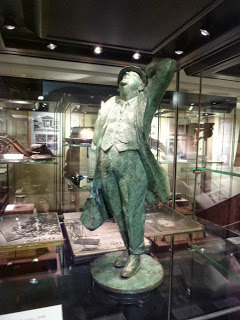 John Betjeman (maquette) by sculptor Martin Jennings, 2006
John Betjeman (maquette) by sculptor Martin Jennings, 2006
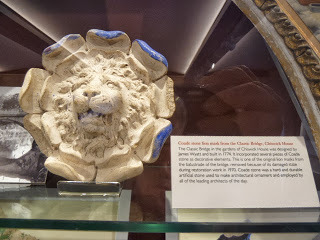 Coade Stone Lion Mask The rosette above came from the Classic Bridge at Chiswick, designed by James Wyatt in 1774; Coade Stone is artificial, often used by leading architects for statues and ornaments.
Coade Stone Lion Mask The rosette above came from the Classic Bridge at Chiswick, designed by James Wyatt in 1774; Coade Stone is artificial, often used by leading architects for statues and ornaments.
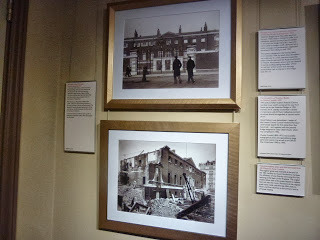 Devonshire House, before and during demolition For more information on this exhibition, click here A group hoping to honor the Duke of Wellington erected a gigantic equestrian statue on top of the arch in 1846. Being out of all proportion to the arch, the statue caused great criticism and even laughter.
Devonshire House, before and during demolition For more information on this exhibition, click here A group hoping to honor the Duke of Wellington erected a gigantic equestrian statue on top of the arch in 1846. Being out of all proportion to the arch, the statue caused great criticism and even laughter.
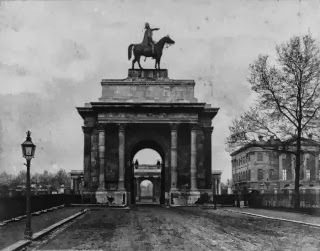 view, about 1860 In 1882-83, The arch was dismantled and rebuilt in its present traffic-bound position. The Statue was moved to Aldershot (after much discussion) where it can be seen today. A few years later, in 1899, Adrian Jones (1845-1938) designed the Quadriga, four horses driven by a boy and crowned by the Angel of Peace. It was completed in 1912.
view, about 1860 In 1882-83, The arch was dismantled and rebuilt in its present traffic-bound position. The Statue was moved to Aldershot (after much discussion) where it can be seen today. A few years later, in 1899, Adrian Jones (1845-1938) designed the Quadriga, four horses driven by a boy and crowned by the Angel of Peace. It was completed in 1912.
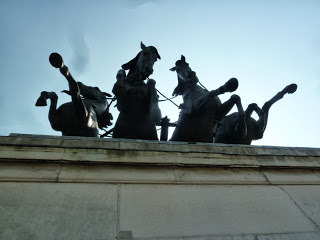
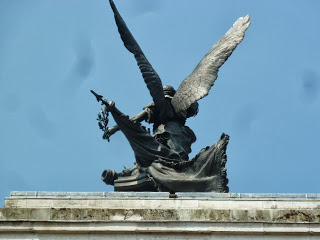 From the front and from the back
From the front and from the back
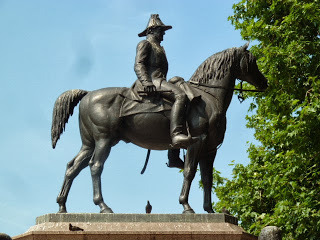 Wellington on Copenhagen holding his telescope Erected in 1888, the statue on the Arch grounds, across the road from Apsley House, was sculpted and cast in bronze by Sir Joseph Edgar Boehm (1834-1890). Boehm was a favorite artist of the royal family and a teacher of sculptress Princess Louise, Duchess of Argyll (1848-1939), Queen Victoria's fourth daughter.
Wellington on Copenhagen holding his telescope Erected in 1888, the statue on the Arch grounds, across the road from Apsley House, was sculpted and cast in bronze by Sir Joseph Edgar Boehm (1834-1890). Boehm was a favorite artist of the royal family and a teacher of sculptress Princess Louise, Duchess of Argyll (1848-1939), Queen Victoria's fourth daughter.
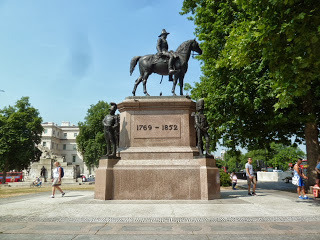 The figures at the four corners of the red granite plinth are guardsmen from Wellington's troops: a Grenadier, a Welsh Fusilier, a Royal Highlander, and an Inniskilling Dragoon.
The figures at the four corners of the red granite plinth are guardsmen from Wellington's troops: a Grenadier, a Welsh Fusilier, a Royal Highlander, and an Inniskilling Dragoon.
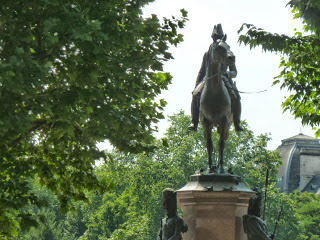 As I mentioned before, the Wellington Arch and the equestrian statue stand in the middle of a traffic circle, joined to the adjacent streets and the Hyde Park Corner Tube stop by underground walkways. The white tile walls are decorated with scenes of Wellington and his troops. Below, a few examples as we walked -- or I walked and Ed limped -- to visit Apsley House.
As I mentioned before, the Wellington Arch and the equestrian statue stand in the middle of a traffic circle, joined to the adjacent streets and the Hyde Park Corner Tube stop by underground walkways. The white tile walls are decorated with scenes of Wellington and his troops. Below, a few examples as we walked -- or I walked and Ed limped -- to visit Apsley House.
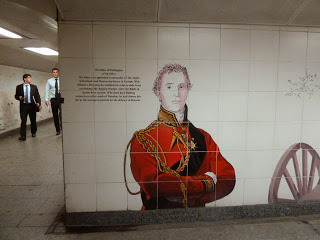
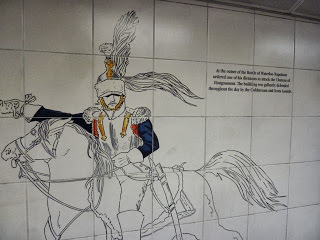
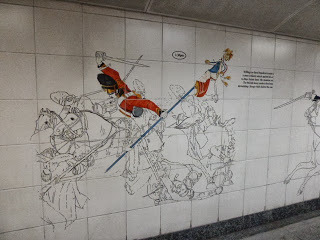
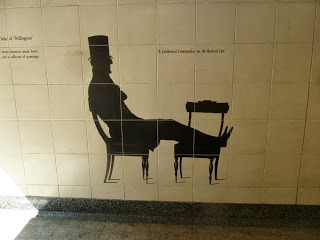
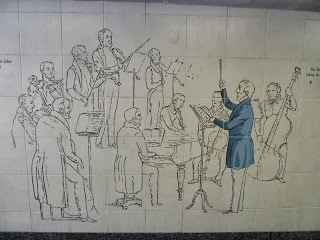
Next, Victoria and Ed visit Apsley House
Despite the fact that I had visited Apsley House several times, with Kristine, with Pat, my sister-in-law, and others, Ed had never been there. So that was second on my list, just behind the Wellington Arch, which I'd never visited. I'd walked past it plenty of times, but it had not been open before. A bit of web checking told me that the Arch recently opened exhibition space, at that time devoted to a study of the many past and current attempt to SAVE British heritage, particularly by protecting buildings and open spaces.
The Wellington Arch website is here.

Soapbox alert!!! It doesn't take much beyond a glance at the London skyline to see how contemporary skyscrapers overpower and almost obliterate the beautiful early 20th century view of St. Paul's Dome and the many graceful steeples and spires. Okay, call me a traditionalist (Guilty!) but I wish the powers-that-be could have kept the tall buildings in groups away from the City, Mayfair and Westminster. Alas, it is far too late.
 View from the Wellington Arch (including a few stray smudges) I have nothing against tall buildings -- I live in one. But if they had been clustered in various neighborhoods away from the center of London, the beautiful skyline would have been preserved. True of a few cities, Washington, D C for example. No high rises downtown, all clustered in the surrounding communities to preserve the views of the Capitol and other monuments. End of soapbox. Please resume your usual activities.
View from the Wellington Arch (including a few stray smudges) I have nothing against tall buildings -- I live in one. But if they had been clustered in various neighborhoods away from the center of London, the beautiful skyline would have been preserved. True of a few cities, Washington, D C for example. No high rises downtown, all clustered in the surrounding communities to preserve the views of the Capitol and other monuments. End of soapbox. Please resume your usual activities.
 At the height of the Roman Empire, triumphal arches were built to commemorate great events. Think of Rome's Arch of Constantine, the Arch of Titus, and so on. The French started building one in 1806 to mark Napoleon's victory in the Battle of Austerlitz, but it remained unfinished for thirty years, now known as the Arc de Triomphe de l'Etoile in Paris. Not to be outdone, the Prince Regent, later King George IV, wanted to memorialize British victory over France..
At the height of the Roman Empire, triumphal arches were built to commemorate great events. Think of Rome's Arch of Constantine, the Arch of Titus, and so on. The French started building one in 1806 to mark Napoleon's victory in the Battle of Austerlitz, but it remained unfinished for thirty years, now known as the Arc de Triomphe de l'Etoile in Paris. Not to be outdone, the Prince Regent, later King George IV, wanted to memorialize British victory over France..
 Wellington Arch; Apsley House at the far right Both the Wellington Arch (aka the Green Park Arch and the Constitution Arch) and the Marble Arch were affected by political arguments over cost, design and placement in the 19th century. Both were moved from their original positions and both stand relatively isolated in the middle of traffic circles surrounded by buses, autos, lorries and other noisy vehicles. Traffic too often trumps landscape. Whoops, soapbox again.
Wellington Arch; Apsley House at the far right Both the Wellington Arch (aka the Green Park Arch and the Constitution Arch) and the Marble Arch were affected by political arguments over cost, design and placement in the 19th century. Both were moved from their original positions and both stand relatively isolated in the middle of traffic circles surrounded by buses, autos, lorries and other noisy vehicles. Traffic too often trumps landscape. Whoops, soapbox again.
 One of the gates, cast in iron by Joseph Bramah and Sons, restored recently The Wellington Arch was designed by Architect Decimus Burton (1800-1881), as his name indicates, the tenth child in his family. He worked with his father, also an architect and John Nash as well. He also designed the Hyde Park screen next to Apsley House.
One of the gates, cast in iron by Joseph Bramah and Sons, restored recently The Wellington Arch was designed by Architect Decimus Burton (1800-1881), as his name indicates, the tenth child in his family. He worked with his father, also an architect and John Nash as well. He also designed the Hyde Park screen next to Apsley House.
 The Hyde Park Screen, 1825
The Hyde Park Screen, 1825
 This picture shows the screen in relation to Apsley House; the Wellington is Arch off the picture to the right A few years ago, English Heritage took over the Wellington Arch and changed it from a small police into to a small gift shop with an exhibition space above. There is access to the viewing balcony at the top as well, all by elevator. Ed's sore foot appreciated that particularly!
This picture shows the screen in relation to Apsley House; the Wellington is Arch off the picture to the right A few years ago, English Heritage took over the Wellington Arch and changed it from a small police into to a small gift shop with an exhibition space above. There is access to the viewing balcony at the top as well, all by elevator. Ed's sore foot appreciated that particularly!
 View down Constitution Hill towards Buckingham Palace
View down Constitution Hill towards Buckingham Palace
 The Exhibition: Pride and Prejudice: The Battle for Betjeman's Britain John Betjeman (1906-1984) was Britain's Poet Laureate in addition to being a popular radio and tv commentator and an avid campaigner for the protection of architectural heritage. Below, the maquette for his statue located in St. Pancras Station, one of the buildings he successfully fought to save.
The Exhibition: Pride and Prejudice: The Battle for Betjeman's Britain John Betjeman (1906-1984) was Britain's Poet Laureate in addition to being a popular radio and tv commentator and an avid campaigner for the protection of architectural heritage. Below, the maquette for his statue located in St. Pancras Station, one of the buildings he successfully fought to save.
 John Betjeman (maquette) by sculptor Martin Jennings, 2006
John Betjeman (maquette) by sculptor Martin Jennings, 2006
 Coade Stone Lion Mask The rosette above came from the Classic Bridge at Chiswick, designed by James Wyatt in 1774; Coade Stone is artificial, often used by leading architects for statues and ornaments.
Coade Stone Lion Mask The rosette above came from the Classic Bridge at Chiswick, designed by James Wyatt in 1774; Coade Stone is artificial, often used by leading architects for statues and ornaments.
 Devonshire House, before and during demolition For more information on this exhibition, click here A group hoping to honor the Duke of Wellington erected a gigantic equestrian statue on top of the arch in 1846. Being out of all proportion to the arch, the statue caused great criticism and even laughter.
Devonshire House, before and during demolition For more information on this exhibition, click here A group hoping to honor the Duke of Wellington erected a gigantic equestrian statue on top of the arch in 1846. Being out of all proportion to the arch, the statue caused great criticism and even laughter.
 view, about 1860 In 1882-83, The arch was dismantled and rebuilt in its present traffic-bound position. The Statue was moved to Aldershot (after much discussion) where it can be seen today. A few years later, in 1899, Adrian Jones (1845-1938) designed the Quadriga, four horses driven by a boy and crowned by the Angel of Peace. It was completed in 1912.
view, about 1860 In 1882-83, The arch was dismantled and rebuilt in its present traffic-bound position. The Statue was moved to Aldershot (after much discussion) where it can be seen today. A few years later, in 1899, Adrian Jones (1845-1938) designed the Quadriga, four horses driven by a boy and crowned by the Angel of Peace. It was completed in 1912.

 From the front and from the back
From the front and from the back
 Wellington on Copenhagen holding his telescope Erected in 1888, the statue on the Arch grounds, across the road from Apsley House, was sculpted and cast in bronze by Sir Joseph Edgar Boehm (1834-1890). Boehm was a favorite artist of the royal family and a teacher of sculptress Princess Louise, Duchess of Argyll (1848-1939), Queen Victoria's fourth daughter.
Wellington on Copenhagen holding his telescope Erected in 1888, the statue on the Arch grounds, across the road from Apsley House, was sculpted and cast in bronze by Sir Joseph Edgar Boehm (1834-1890). Boehm was a favorite artist of the royal family and a teacher of sculptress Princess Louise, Duchess of Argyll (1848-1939), Queen Victoria's fourth daughter. The figures at the four corners of the red granite plinth are guardsmen from Wellington's troops: a Grenadier, a Welsh Fusilier, a Royal Highlander, and an Inniskilling Dragoon.
The figures at the four corners of the red granite plinth are guardsmen from Wellington's troops: a Grenadier, a Welsh Fusilier, a Royal Highlander, and an Inniskilling Dragoon.
 As I mentioned before, the Wellington Arch and the equestrian statue stand in the middle of a traffic circle, joined to the adjacent streets and the Hyde Park Corner Tube stop by underground walkways. The white tile walls are decorated with scenes of Wellington and his troops. Below, a few examples as we walked -- or I walked and Ed limped -- to visit Apsley House.
As I mentioned before, the Wellington Arch and the equestrian statue stand in the middle of a traffic circle, joined to the adjacent streets and the Hyde Park Corner Tube stop by underground walkways. The white tile walls are decorated with scenes of Wellington and his troops. Below, a few examples as we walked -- or I walked and Ed limped -- to visit Apsley House.





Next, Victoria and Ed visit Apsley House
Published on November 04, 2013 00:30
Kristine Hughes's Blog
- Kristine Hughes's profile
- 6 followers
Kristine Hughes isn't a Goodreads Author
(yet),
but they
do have a blog,
so here are some recent posts imported from
their feed.



